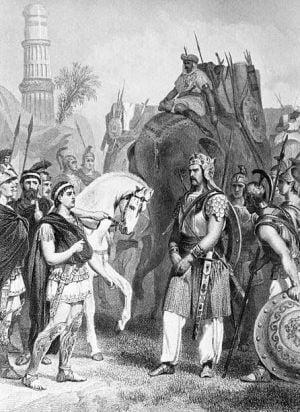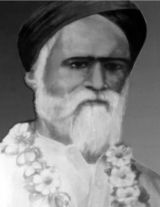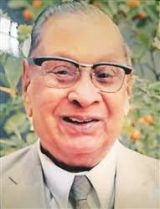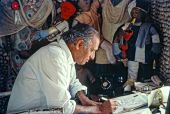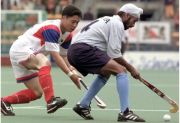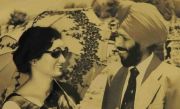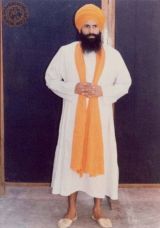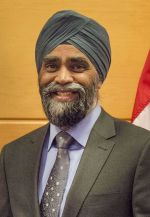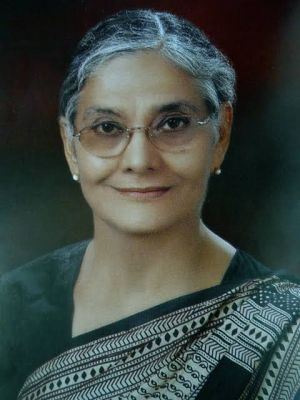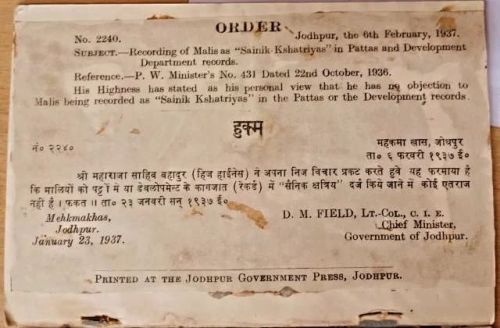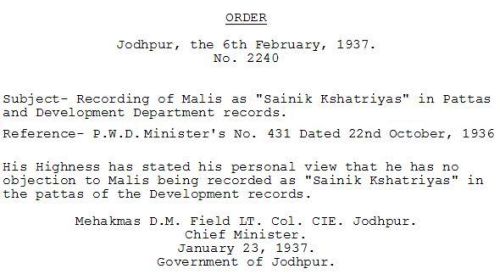Saini: Difference between revisions
| Line 627: | Line 627: | ||
[[Image:InduBanga.jpg|thumb|300px|InduBanga|link=Special:FilePath/InduBanga.jpg]] | [[Image:InduBanga.jpg|thumb|300px|InduBanga|link=Special:FilePath/InduBanga.jpg]] | ||
Indu Banga is Professor of History at Punjab University, Chandigarh. Her publications include Historiography on the Sikh Power in Punjab (1985). | Indu Banga is Professor of History at Punjab University, Chandigarh. Her publications include Historiography on the Sikh Power in Punjab (1985). | ||
*'''Shobhit Banwait-Musical artist''' | |||
Born and raised in Toronto, Canada and he has a huge passion for music, sports and acting. I've been a professional percussionist since the age of 18 playing South Asian drums called, Tabla, Dholak and various other small percussions. His musical style gained worldwide attention in 2016 after he fused his percussions with top 40 music. Pop stars like Sia, have personally recognized his fusion cover of her smash hit, “Cheap Thrills.” CBC, Hindustan Times, Virgin Radio, NDTV, Buzzfeed, and other various news outlets across the world have all recognized his work. He was featured in magazines like the Cosmopolitan, Femina, and Harper’s Bazaar and won multiple musical awards locally and internationally. [https://www.mandy.com/ca/a/shobhit-banwait] | |||
==Geographic distribution and relative population size == | ==Geographic distribution and relative population size == | ||
Revision as of 08:01, 30 January 2024
|
Sikhism does not endorse caste based distinctions in society that lead to unequal opportunities for some people. In fact, Sikhism completely rejects class or race based distinctions between humans, that leads us to make an inequitable society. Such distinctions have surfaced only due to ill interests of certain section of people, who, on the pretext of making a society more manageable through these classifications, eventually paved the way to an unequal grouping within the human race. This article is just for information purpose and to share how people from different castes came into the Sikh fold. So, please treat this article as a source of general information about this issue and kindly do not amend this article to highlight this important underlying Sikh principle. If you have any comments, please discuss them appropriately here |
"In the Punjab in the sub- mountainous region the community came to be known as 'Saini'. It maintained its Rajput character despite migration." [1]
"The Sainis trace their origin to a Rajput clan of Chandravanshi Lineage who came from their original home near Mathura [sic] on the Jamuna, south of Delhi,They came to Panjab to thwart the repeated attacks of Ghazni's generals on this area on Hindus in the first Muhammadan invasions from there Origin land Mathura.These specific battles are said to be duly recorded in Tarikh-i-Alfi. "[2][15]
Saini(Gurmukhi-ਸੈਣੀ/Devnagri-सैनी) is a warrior caste of India and a prominent group among Sikhs. Sainis, also known as Shoorsaini in Puranic literature.The name "Shoor" Means 'Valiant' and "Saini" means 'Warrior'.Now the it has been Reduced to "Saini" Translating to 'Warrior'. Shoorsaini was the name of Tomara-Yaduvanshi tribe which ruled areas surrounding Delhi, Mathura, Bayana and Bharatpur. They are now found by their original name only in Punjab(Shoorsainis had moved to Punjab after Mahabharata war) and in the neighboring states of Haryana, Jammu and Kashmir and Himachal Pradesh. The Saini Sikhs are found in the sub-mountainous region of Punjab. They dominate in a significant number of villages in Hoshiarpur, Nawanshehr, Jalandhar, Ropar and Gurdaspur. The neighboring sub-mountainous districts of Haryana and Himachal Pradesh also have considerable Saini Sikh population. They are not found in any significant numbers in the lower and the interior Punjab, although the descendants of Sardar Nanu Singh Saini of Phulkian, who were a part of the Patiala nobility, at one time held one of the largest estates in the erstwhile princely state. Their real strongholds , however, are in the areas of Jalandhar and Bari Doabs where they exclusively own a large number of villages, and where they also held the Zaildari in the British era. They are descendant from Rajputs [1] of the Yaduvanshi [3] [4] Surasena[5] [6] lineage, originating from Yadava King Shoorsen, who was the grandfather of both Krishna and the legendary Pandava warriors and also by their folk memory of origin from Mathura which was the theo-political capital of the Shoorsaini kingdom founded by Yadava king Shoorsen in the time of Mahabharata. Sainis relocated to Punjab from Mathura and surrounding areas over different periods of time.[1] [7]
The ancient Greek traveller and ambassador to India, Megasthenes, also came across this clan in its glory days as the ruling tribe with its capital in Mathura. There is also now an academic consensus that the ancient King Porus, the celebrated opponent of Alexander the Great, belonged to this once most dominant Yadava sect. [8] [9][10] Megasthenes described this tribe as Sourasenoi. [11]
Šúraséna was the grandfather of Krishna, and from him Krishna and his descendants, who held Mathura after the death of Kansa(Krishna's Uncle), derived their name as Šúrasénas or Shoorsainis.
Sainis ruled this kingdom ruled Mathura in a period ranging between 700 and 1100 CE(right up to the time of earliest Muhammadan invasions), is recorded by historians such as Cunningham. As per the historical and local accounts, when these Rajputs lost these battles and Lost there Rule during the war they had no choice other than facing slaughter or conversion to Islam. Now the Other Rajputs with Rule over a Province or State believed that A Rajput Without a Jagir is Not a Rajput(Jagir=Manor). And Some Rajputs converted under duress and started being addressed with the names such as Ranghars, Khanzadas, Ghauri Pathans, etc. Some, desperate to retain their estates and influence, started marrying their women to the Muslim conquerors as part of the prevalent "Dola" culture. This was considered a reprobate practice by the orthodox Hindus. These Rajputs among Mahtons were thus considered degraded and the inter-marriage between them and the other Rajputs stopped. This led to the birth of various endogamous groupings within the Rajputs.
Some Rajputs living under the sword in the Muslim-ruled areas , however, took to nuancing their identities in various ways to escape conversion and "Dola" enforced ritual pollution targeted at the rebellious Rajput groups (and also Brahmins in some cases) . The Sainis are said to be one such Rajput group who took up agriculture in this era. Many of their clan names such as Badwal, Tirotia, Salaria, Dhamrait, Mangar, Darar, Gehlon, Tambar, Banwait and others are identical or very similar to those of the Rajputs found on the neighboring hills which suggests that both were at one time part of the same stock which later got fragmented into separate groups due to the reasons already mentioned. The comparative ABO distribution studies conducted on both the groups, which were published in the prestigious American Journal of Physical Anthropology in 1961, had confirmed identical genetic markers of both the groups, while at the same time showing significant differences between them and those of other leading castes of the area such as Jats, Aroras, etc. This also strongly indicates a common ancestry. The oral and historical accounts thus do have some scientific corroboration in this particular case.
Like most other Rajput origin tribes of Punjab [12] , Saini's also took up farming during medieval period due to the Turko-Islamic political domination, and have been chiefly engaged in both agriculture and military service since then until the recent times.[13] During British period Saini's were enlisted as a statutory agricultural tribe as well as a martial class. [14] [15] [16]
"Sainis fought first as part of Rajputs and then as Sikhs. So their attire as warriors would have been indistinctive from them. Modern Sainis in the Indian Army wear the colors of their regimental units. In British era Sainis fought largely in Grenadiers , Sappers and Sikh Regiments. Subedar-Major Jagindar Singh Saini who was a hero of Battle of Loos in the World War 1 won Order of Brithish India and the title of 'Bahadur'. He wore gray and red stripes on the shoulders. Gurmukh Singh Saini won the Cross of St. George in the same battle which was worn around the neck. But these decorations were worn by all members of all groups who won military awards for gallantry.
Until recent times Saini's were strictly an endogamous Kshatriya group and inter-married only within select clans. [17] They also have a national level organization called Saini Rajput Mahasabha located at Delhi which was established in 1920. [18]
Since 1931 the surname Saini is also used by Mali groups of Rajasthan and some other states. Officially started being known as Saini in 1937.These however are different from the Sainis that are found in Punjab, Himachal Pradesh, Jammu-Kashmir ,and Parts of Haryana. And have no marital links with them.
Kansa
Kansa(brother of Krishna's mother Devaki), the first major king of Northern India, was from this dynasty. By virtue of his might, he declared himself as the first king of Mathura. Acknowledging his superiority, the famous king Jarasandha of Magadha, who had established his lordship in the eastern region of India by subduing many independent kingdoms, offered his two daughters in marriage to Kansa. Thus, the first empire of pre-historic or Proto-history India was established by Kansa, the scion of Shoorsaini dynasty. Kansa performed the famous Ashwamedha Yagna and set his horse moving and his armies followed the horse under his personal command and was away for twelve years from the capital “Shoorpur” in the city of Mathura. The site of king Kansa's capital city was discovered by Colonel James Todd, the author of the Annals and Antiquities of Rajasthan.
In the Mahabharata's 18th Parva ("Chapter"), the sons of king Kansa are mentioned to be alive. Moreover even after the killing of Kansa the kingdom was given back to his father, Ugrasena who ruled Mathura. Mathura still teems with the remains and relics of king Kansa. In the city of Jhajjar (Haryana), there are about 150-200 families who trace their descent from Kansa.
Sourasenoi: Greek account of ancient Saini royal clan
A non-Indian account of this ancient royal tribe has also survived. Megasthenes, the Greek ambassador to India in 4 BCE transliterated the name Shoorsaini into 'Greek' as 'Sourasenoi', saying that they were worshipers of Lord Krishna whom he identified as none other than the Greek Demi-God 'Herakles' (ed. Hercules). [11]:
- "This Herakles is held in special honour by the Sourasenoi, an Indian tribe, who possess two large cities, Methora and Cleisobora"
Source: James Tod, Annals and Antiquities of Rajasthan [11]
Porus: An Ancient Saini King
Porus or Puru, the son of king Chandra Sen, was the last Shoorsaini king. He was the overlord of the fertile area of the Punjab between the rivers Jhelum and Beas. Porus is also known in history as the 'Lord of the Mountains.' His bravery and gallantry has become an embodiment of Indian heroism. Prof. P.D. Oak rather argues and advocates and has tried to prove in his book – “Blunders of Indian History” – (Bhartiya Itihas ki Bhari Bhulein), that in the war with Alexander the Great, Porus had in fact won and Alexander had been defeated. That is why Porus did not allow Alexander to return by the route he arrived. Alexander had to carve out a new path for his return. Prof. Oak has tried his best and has dished out very powerful and convincing arguments.
The most shrewd politician of ancient India – Chanakya (Kautilya), the architect of the Mauryan Empire heavily depended on the military help of Porus to groom and raise Chandragupta as the future ruler of Patliputra. Chanakya's plan was based on the military might of Porus and they agreed to partition the Empire into equal halves. Porus sent his son as the commander of his army to pursue the task of ousting the Nanda ruler of Patliputra. It was the fearful might of Porus' forces that cowed Nanda’s army allowing Chanakya's successful siege of the city that ended in securing a victory. But as was the temperament of Chanakya, he betrayed the son of Porus and had him treacherously assassinated. The brave Shoorsaini, true to his royal lineage fell victim to Chanakya's intrigues and evil designs.
- An interesting aspect to note here, is that in addition to the Sainis, three other tribes of the Punjab claim King Porus to be one of their own. These include Janjuas, Kukhran Khatris and Mohyal Brahmins of the Vaid clan.
However historians have now a firm consensus that Porus was a Saini in light of the following references:
- '"....we have elsewhere assigned to Yadus of the Punjab the honour of furnishing the well known king named Porus"'
- Source: James Tod, Annals and Antiquities of Rajasthan , pp 283 [8]
There were no known Hindu textual sources regarding Porus indicating the tribe or ethnic group he belonged to. As would be evident from further analysis of scholarly opinion the academic consensus seems to be that he was a Yadava Shoorsaini king. Col. Tod was the proponent of this view which was also held by Dr. Ishwari Prashad, another renowned historian. [8] [19][20]
Col. Tod went on further specifically point out Shoorsainis as the Puru tribe whose king was called Porus, the legendary Indian adversary of Alexander the Great:
- "Puru became the patronymic of this branch of the Lunar race. Of this Alexander's historians made Porus. The Suraseni of Methoras (descendants of the Soor Sen of Mathura) were all Purus, the Prasioi of Megasthenes..."
- Source: Annals and Antiquities of Rajast'han, Or, The Central and Western Rajpoot States of India, James Tod, pp 36 [21]
After careful analysis a body of scholars at the Indian History Congress (…the largest professional and academic body of Indian historians with over 10,000 members. It was established in 1935.) declared that king Porus, known for his legendary bravery, belonged to the Shoorsaini tribe ('Sourasenoi' in Greek) also based on the fact that his infantry carried the image of Lord Krishna (Herakles as per the Greeks) on their banners. Lord Krishna was both the ancestor and patron deity of Shoorsainis. [9] [10][22][23]
Saini Yadavas and Kushan rule
After the fall of Porus and his sons, a new barbaric tribe of Central Asia, the Kushans, crossed the Indus and established their rule in India. During this period Saini or Shoorsaini Yadava dynasty lost prominence for a few centuries only to reappear again in Mathura around the 8th century CE.
Post-Kushan Saini rule of Mathura & Kaman: chaonsat-khamba inscription
A Sanskrit inscription was dicovered on a pillar by one Pandit Bhagvan Lal Indraji in 19th century [24] on one of the well-known Chaonsat-khamba , or " sixty-four pillars ", in Kaman. This inscription was dated by Cunningham to be of around 8th CE[1][24]
The inscription gives following genealogy of the Surasena (or Saini) dynasty extending over seven kings[25] :
1. — Phakka, married Deyika.
2. — Kula-abhata (son), married Drangeni.
3. — Ajita (son), married Apsarapriya.
4. — Durgabhata (son), married Vachchhalika.
5. — Durgadaman (son), married Vachchhika.
6. — Devaraja (son), married Yajnika.
7. — Vatsadaman (son).
The old fort of Kaman lies between two low ranges of hills on the high road from Delhi to Bayana. Owing to its position it is conjectured that it must have fallen an early prey to the Muhammadan conquerors.[24]. This account explains well the native accounts of the Sainis of Punjab that their forefathers were the Rajputs of Mathura and migrated to Punjab after Muslim invasions of Mathura region.[4][1][26][27]
Kaman is situated in the Bharatpur territory, 39 miles to the north-west of Mathura, and 14 miles to the north of Dig.
Estimating the probable dates of this Surasena or Saini dynasty kings, writes Cunningham [25]:
"If we place Vatsadaman in A.D. 750 to 775, the head of the family, Phakka, will date from A.D. 600, reckoning twenty five years to each generation. As none of the names agree with those of the Yadava princes of Bayana, as recorded by the bards, it seems probable that these chiefs of Kaman, or Kadamba-vana, were only a branch of the famous Surasenas of Mathura."
It is also believed by the archaeologists that the Visnu temple of Kaman was built by Saini queen Vachchhika [25].
Medieval India
Banveer, the son of Queen Sheetla Saini ruled as the Rana of Mewar, from Chittor for eight years till the consecration of Udai Singh as Rana. Eventually, "Shoorsaini" was shortened to "Saini".
The British Period
During British period Sainis were enlisted as a statutory agricultural tribe as well as a martial class.Sainis have a distinguished record as soldiers in the armies of pre-British princely states, British India and independent India. Sainis fought in both the World Wars and won some of the highest gallantry awards for 'conspicuous bravery'.[28] [29] [30]Subedar Joginder Singh, who won Param Vir Chakra, Indian Army's highest war time gallantry award, in 1962 India-China War was also a Saini of Sahnan sub clan.
During the British era, several influential Saini landlords were also appointed as Zaildars, or revenue-collectors, in many districts of Punjab and modern Haryana. [31] [32][33] [34]
Saini's also took active part in the freedom movement of India and many insurgents from Saini community were either martyred or imprisoned during the days of British Raj. [35][36] [37] [38] [39]
During the revolt of 1857, the Sainis of Kurukshetra and the Rors of Karnal were among the Hindu and Muslim elements who, valiantly fought the British seeking to re-establish the sovereignty of their Princely rulers.
The principalities of Sirmaur in Himachal Pradesh as well as Jagadhri, Kirada and Hansi in Haryana are Saini strongholds.
Known Saini freedom-fighters and martyrs
- Gurdan Saini (Rajput General- martyred in Ranthambore)
- Mayya Singh Saini (imprisoned) [40]
- Gurmukh Singh Saini (IOM, Cr St Geo) , a Sikh soldier from the village Gadram Badi of Ropar in district Ambala of the province of Punjab in British India, won the Indian Order of Merit 1st Class in World War I for splendid courage on the battlefield on the night of March 1, 1916.
- Gulab Singh Saini (martyred-hanged on January 9, 1858 ) [39] [41]
- Chaudhary Yograj Saini of Gambhowal (Kuka Movement, 13 years imprisonment) [42]
- Bhai Bela Singh (martyr of Nankana Sahib)[16][43]
- Harnam Singh of village Baghpur (Jaito Morcha, martyred, died in Jail) [42]
- Dasondha Singh Saini (martyred- died in jail) [35]
- Kehar Singh Saini (martyred- killed in police encounter) [35]
- Basant Singh s/o Prabhu Saini of Mahilpur (imprisoned) [44][42]
- Dal Singh (imprisoned) [44]
- Gurdial Singh of village Urapar (imprisoned, INA veteran) [44]
- Amar Singh s/o Sant Ram of village Orhpur (INA veteran) [42]
- Gian Singh of village Bajidpur (imprisoned, INA veteran)[44]
- Bhan Singh of village Jalowal (imprisoned) [44]
- Battan Singh of village Haveli (INA veteran, imprisoned)[44]
- Nama Saini of Fatehgarh (Ghadar movement, martyred - hanged on January 5, 1917 after 3rd Lahore Conspiracy case trial) [42][45]
- Pritam Saini (Ghadar movement, imprisoned) [46]
- Bachan Singh Saini (Ghadar movement, imprisoned) [47]
- Naik Gurdial Singh Saini (imprisoned, INA veteran)[48]
- Gonda Singh (Babbar Akali, imprisoned and tortured) [49]
- Mohinder Singh Saini of Pandori Ganga Singh (Babbar Akali, martyred, killed in Babeli Police encounter)[49][42]
- Chinta Singh Saini of Pandori Ganga Singh (Babbar Akali, martyred, hanged)[49][42]
- Harnam Singh Saini s/o Sunder Singh of Pandori Ganga Singh (National Movement, imprisoned for 1.5 years)[49][42]
- Harnam Singh Saini s/o Rajmal of Pandori Ganga Singh (imprisoned for 2 years, INA veteran)[49] [42]
- Hazara Singh Saini of Pandori Ganga Singh (Civil Disobedience, Babar Akali, imprisoned for 6 years)[49] [42]
- Inder Singh Saini of Pandori Ganga Singh (Babar Akali, imprisoned for 7 years)[49] [42]
- Kartar Singh Saini of Pandori Ganga Singh (Babar Akali, sentence not known)[49] [42]
- Arjan Singh of village Sujjon, Banga (Ghadar movement activist)[50]
- Satya Pal Saini of Lahore (tortured and imprisoned) [51]
- Narain Singh Nanua (INA veteran, imprisoned)[51]
- Ishar Singh (Babbar Akali, imprisoned and tortured)[49]
- Labh Singh Saini (Akali leader, martyred)
- Harnam Singh Saini (Ghadar movement, martyred - hanged on March 16 , 1917 after Lahore Conspiracy Case trial) [36] [52]
- Mahan Singh Gahunia of Phillipines (noted INA civilian organizer-donated his entire wealth to INA) [37]
- Sadhu Ram Saini (veteran Gandhian, imprisoned) [53] [54]
- Ajit Saini of Punjab (INA veteran, imprisoned) a Freedom fighter and an acclaimed writer and columnist, also a close lieutenant of Subhas Chandra Bose who assigned him the duty to propagate the slogan “Jai hind,” among the common masses. [38]
- Amar Singh (imprisoned)[53] [54]
Note: This list is not exhaustive.
Epic Saini warriors
Inam-holding Saini feudals during British era
The following is the list of some of the Saini Zaildars during 1880s:
- Chaudhari Jawahir Singh of Hoshiarpur [31] had 19 villages under him.
- Chaudhari Jaimal Singh of Dasuya [31] had 22 villages under him.
- Chaudhari Nand Ram Saini of Hissar.[33]
- Rai Bahadur Chaudhari Dewan Chand Saini of Gurdaspur [32] [34] was a well-known Saini safedposh during 20th century. He was a highly reputed criminal lawyer of Lahore High Court who later became the leader of Criminal Bar. He was also subsequently awarded the title of 'Rai Bahadur' by the British government.[32] [34]
Note: This list is not exhaustive. More information is needed for Ropar , Jalandhar, and Gurdaspur districts, and also for Hoshiarpur, over different periods of time before 1947.
Lord Krishna and Balrama
The story of the epic Saini warriors begins with the mention of Lord Krishna and his elder brother Balrama. Krishna was a warrior-statesman who gave the Yadavas leadership at a very critical juncture. Krishna's and Balrama's exploits as warriors, mentioned in various hagiographies, are too numerous and too popular to need any mention here.
Some critics trained in the Western scholastic traditions have doubted the existence of a historical Krishna but such commentaries are now clearly contradicted by archaeological evidence found in the recent underwater excavations in the Arabian sea which have revealed a submerged ancient city[55] as described in Visnu Purana. This evidence along with myriads of sites and clans found all over India claiming association with Krishna indicate the distinct possibility of a historical Krishna.
Visnu Purana vividly describes in detail various military expeditions that Krisna led. Incidentally this text also gives clear proof that Shoorsaini Yadavas, whence Sainis of Punjab claim descent, moved to Dwarka and eventually some of them moved to Punjab after submersion of Dwarka into the sea.[7]
Krishna defined the warrior-statesman and saint-soldier ideal not only for his kinsmen and descendants, distributed in diverse clans all over India now, which also include Sainis of Punjab, but also for the entire mankind. His military exploits and warrior spirit are even invoked in an anachronistic way in the Sikh tradition in the Chobis avatar section of Sri Dasam Granth.
In the Shaster Naam Mala section of Sri Dasam Granth, the names of Balrama and Krisna are invoked as follow to instill the warrior spirit.[56]
ਹਲਧਰ ਸਬਦ ਬਖਾਨਿ ਕੈ ਅਨੁਜ ਉਚਰਿ ਅਰਿ ਭਾਖੁ ॥ ਸਕਲ ਨਾਮ ਸ੍ਰੀ ਬਾਨ ਕੇ ਚੀਨਿ ਚਤੁਰ ਚਿਤ ਰਾਖੁ ॥੧੪੧॥
हलधर शबद बखानि कै अनढ़ज उचरि अरि भाखढ़ ॥ सकल नाम सढ़री बान के चीन चतढ़र चित राखढ़ ॥१४१॥
After speaking the word "Haldhar" (Balrama), then adding "Anuj" (Krishna) and afterwards saying "Ari" (Foe), the wise people know all the names of "Baan" (Arrow).
Medieval Saini warriors
Gurdan Singh Saini
Noted historians Henry Miers Elliot and John Dowson on page 541 of their work "The History of India, as Told by Its Own Historians. The Muhammadan Period" [57] citing Ghurratu-L-Kamal , a work by Khalji dynasty's royal poet-scholar Amir Khusro, provide the following account of a distinguished Saini general in the Sisodia Rajput army of Rana Hamir that took on Alauddin Khilji's Turk army:
The rai was in affright, and sent for Gurdan Saini, who was the most experienced warrior amongst the 40,000 rawats under the rai, and had seen many fights among the Hindus. "Sometimes he had gone with the advance to Malwa ; sometimes he had gone plundering in Gujarat." The Saini took 10,000 rawats with him from Jhain, and advanced against the Turks, and, after a severe action, he was slain...
The account of this Saini general who commanded a force of 10,000 Rajput fighters and achieved martyrdom almost reads like an unqualified eulogy even from a hostile Turk perspective.
A Saini Commander of a premier Sisodia Rajput force
Gurdan Saini was most likely linked with the famed Yaduvanshi Surasenas of Mathura, some of whom disperesed to Jalandhar doab in Punjab after the Turk invasion of Mathura. [26] [58] [1] The term 'Surasena' (also spelt Shurasena) is a Sanskrit version of Prakrit 'Shoorsaini'. 'Shoorsaini' further gets abbreviated to just 'Saini' in layman usage.
Jarnail Sardar Nanu Singh Saini, Jagirdar, Phulkiyan
Sardar Nanu Singh Saini was a Sikh army general and a well-known jagirdar in Phulkian riyasat. He was a close associate of Maharaja Ala Singh who founded the Patiala state in 1753 AD.
He gained this jagir from Maharaja Ala Singh as a recognition and reward for having liberated him from the Sunam prison in 1747 where he had been incarcerated by Ali Muhammad Khan for over two years. More in:-
- Main article: Sardar Nanu Singh Saini
Jarnail Sardar Sangat Singh Saini
Sardar Sangat Singh Saini was a distinguished and highly ranked General in Khalsa army under Maharaja Ranjit Singh. [59] It is said that the Maharaja was so impressed with his contributions in the military campaigns that he granted him a fief. The town Sangatpur in district Gurdaspur is named after this illustrious Saini General.[59]
Incidentally, Gurdaspur is another area of Saini concentration in Punjab.
Bhai Jamala Singh Nanua
Nanua Bairagi , also known as Nanua Bhagat and Jamala Singh, was a renowned mystic, humanitarian and Sikh warrior of Punjab. He was a stalwart of Saini community and was a close associate and disciple of last three Sikh gurus , whom he had the honour of serving in person. More in:-
- Main article: Nanua Bairagi
Bibi Sharan Kaur Pabla
Sharan Kaur Pabla was a Sikh martyr who was slain in 1705 by Mughal soldiers while cremating the bodies of the two older sons of Guru Gobind Singh, the 10th Sikh Guru, after the battle of Chamkaur. She was from the village Raipur Rani which is 2 KM from the famous town of Chamkaur. More in:-
- Main article: Bibi Sharan Kaur Pabla
Mayya Singh Saini
Mayya Singh Saini , sometimes spelt as Maya Singh Saini, [60] [61] [62] [63][64] [65] was a Saini cavalryman and a notable freedom-fighter from Naushahra in Amritsar district of the Punjab. Mayya Singh was an ace horseman and fought in the battle of Ramnagar on 22 November 1848 during the second Anglo-Sikh war. Although the battle of Ramnagar was inconclusive , the Sikh cavalry caused heavy damage to the British forces, which proved to be a great morale booster for the Sikhs.
Thereafter he joined volunteer corps of Bhai Maharaj Singh[17] leader of the popular revolt against the British. He participated in the battles of Sa`dullapur and Gujrat. After the defeat of the Sikh forces, Mayya Singh was in Bhai Maharaj Singh`s train at Sujoval near Balala. From the latter place he was sent to Lahore on a mission, and thus escaped arrest when Maharaj Singh and his companions were captured on the night of 28 and 29 December 1849. He, however, fell into the hands of the British soon afterwards.
It is not clear from the account available whether Mayya Singh was a commander or just an ordinary cavalryman. But given the fact that his contributions were significant enough for his account to have survived in the history texts, there is a strong possibility that he held a significant rank in the Khalsa army. However, his major contributions came after the Anglo-Sikh war as armed insurgent against the rule of East India Company.[66]
Mayya Singh is among many other unsung Saini heroes who fought as part of the Khalsa armies since the time of the 6th Sikh Guru Hargobind. Mayya Singh is fortunate in the sense that his account survived while other Saini heroes just faded into oblivion after selfless service to their motherland. This could be due to two factors. First of them being poor record keeping by Saini community about their foremost men. This neglect continues even to this day. The second factor being the casteless character of the Khalsa order itself which downplayed caste identities.
Senapati Shaheed Gulab Singh Saini
Gulab Singh Saini [67] , son of Jodh Singh Saini, was a close companion of a Jat chief Nahar Singh of Ballabhgarh and laid down his life fighting the British in 1858. Raja Nahar Singh had also lost his life heroically in the process. Gulab Singh Saini was one of the prominent leaders of the native insurrection against the British during the mutiny in his role as the commander-in-chief [67] of the princely state of Ballabhgarh.
He was hanged , along with Jat chief Nahar Singh, in the Chandni Chowk of New Delhi on January 9, 1858 . Thereupon, all of his property and land was confiscated by the British colonialists and all public records pertaining to him and his companions were burnt down to erase the influence of their martyrdom on the natives [67] but the tales of patriotism , gallantry and sacrifice of these heroes of India's first war of freedom still managed to endure in the popular memory despite the twin scourge of colonial oppression and time.
Shaheed Gulab Singh Saini's descendant, Ranjit Singh Saini, is a distinguished scholar of Sanskrit who has authored several books on Sanskrit grammar and historical manuscripts.
Along with Mayya Singh, Gulab Singh was the second prominent Saini hero of the 1857 mutiny and before who fought the East India Company and faced either incarceration or martyrdom.
Saini , Jat and Ror communities around the area of Kurukshetra are reported to have put up a very brave resistance to the forces of East India Company during the mutiny.
Modern Saini warriors (only decorated Saini armymen and policemen)
The awards list given below is not exhaustive. Not all Sainis use their clan or sub clan names and go by the last names such as 'Chaudhry', 'Singh', 'Kumar', etc. Since these names are shared by many other groups (some of which overlap Sainis) such as Jats, Dogras and Other Rajputs etc , it is not possible to isolate Sainis among them just by their last names. The following list pertains only to those decorated armymen and policemen who are confirmed to be Sainis. The actual list of decorated Saini army and police personnel might be much longer. More quality research is needed in this reference.
The following list only contains only those army men and policemen who won have major wartime and peacetime awards. The list of Sainis in Indian Army is very large and needs no inclusion here. Army and police have traditionally been major sources of employment for Sainis. British had classified Sainis as a 'martial race' Listed Seperately from other Rajput Clans.
Sainis are merely a sub-tribe of Yaduvanshi Kshatriyas (or Jadon Rajputs) who took to agriculture in Punjab and spun-off with a distinct identity local predominantly to Punjab and bordering regions. Saini Yaduvanshi clan lost their rule, during war with muslim invaders. They trace their lineage from yaduvanshi clan of kshatriya rajput just like Clans of Jadon, Bhati, Jadeja.
Another fact that needs to be born in mind is comparison of Sainis with Dogras, Pushtuns, Jats and Mahtons is not an apples to apples comparison. Their numbers are relatively very small compared with these groups. For example according to the 1881 census, the entire Saini population in the whole of undivided Punjab- also all of pre-partition India for that matter- was only 132,000 while the population of just a single Jat clan of Sidhus was 208,000. The Saini population was reduced to 106,000 in 1901 census after mistakes of 1881 census were corrected.[68] [69] The best way to gauge proportionate Saini contribution to feats of gallantry in armed forces would be by comparing them individually with other Rajput sub tribes such as Bhati, Chauhan, Sisodia, etc rather than Mahtons, Jats, Khatri or Dogras as integrated groups which are extremely large and heterogeneous when compared to Sainis.
Known Gallantry Awards
During British India (World War I)
- 1 Cross of St. George (Imperial Russia's highest exclusively military award. Equivalent to current Param Vir Chakra and British Victoria Cross) [28]
- 2 Indian Order of Merit (after 1912 equivalent to current Maha Vir Chakra )
- 1 Order of British India(equivalent to Ati Vishisht Seva Medal; recipient decorated with title 'Bahadur')
Note: In addition to these Wing Commander Kartar Singh Taunque was the first personnel of Indian Airforce to win a gallantry award as part of Royal Indian Airforce. The Chakra class of gallantry awards did not yet exist as Taunque won this award in 1938 during World War II before the independence of India. More information is required for the gallantry awards won by Sainis during both the World Wars.
Since Independence
- 1 Param Vir Chakra (Victoria Cross before 1947)
- 1 Vir Chakra
- 4 Shaurya Chakras
- 1 Bronze Star (US Army)
- 13 Sena Medals
- 1 Purple Heart (US Army)
Known Meritorious Service Awards
- 2 Param Vishisht Seva Medals
- 2 Ati Vishist Seva Medal
- 5 Vishisht Seva Medals
Decorated Saini armymen and paramilitary personnel
Order of names given below is as per the rank held at the time of retirement or martyrdom of each soldier.
- Lt Gen Ashok Kumar Saini (Param Vishisht Seva Medal, Ati Visisht Seva Metal, Sena Medal)[18]
- Brigadier Ram Prakash Saini (Vishisht Seva Medal) [19]
- Brigadier SK Saini (Sena Medal for Gallantry) [71]
- Brigadier Balbir Singh Pama (Sena Medal) [72]
- Group Captain Krishan Kumar Sangar (Shaurya Chakra, Vayu Sena Medal for Gallantry)[73]
- Group Captain Girish Saini (Vayu Sena Medal for Gallantry)[20]
- Wing Commander Kartar Singh Taunque (Distinguished Flying Cross-First IAF personnel ever to be decorated for gallantry)[75][76]
- Wing Commander Krishan Kant Saini ( 1962 War Hero, Vir Chakra, Vayu Sena Medal for Gallantry & Ati Vishist Seva Medal)
- Deputy Lieutenant Dr. Jagjit Singh Taunque
Dr Jagjit Singh Taunque MBE, DL (Hindi: जगजीत सिंह) is a retired Deputy Lieutenant of the West Midlands. He has represented the Birmingham Inter Faiths Council on the University Court since 1995, becoming an Honorary Life Member of the Court in 1998. He is also Chairman of the Birmingham Valuation Tribunal and of the Punjab Culture Centre, Trustee of Birmingham Council of Faiths and Patron of Birmingham International Council. He was appointed a Member of the Order of the British Empire (MBE) in June 2000. He is a retired Deputy Lieutenant of West Midlands.
- Sergeant Uday Singh Taunque
Sergeant Uday Singh (1982–2003) was the first U.S. Army soldier of Indian descent to die during Operation Iraqi Freedom. He was born in a Punjabi Sikh Saini family. His death in Iraq was widely reported in the Indian and American media.
- Col Satinder Kumar Saini (Former Vice Chief of the Army Staff of India,Vishisht Seva Medal) [77] Saini is from District Hoshiarpur in Punjab, an alumnus of Sainik School, Kapurthala, National Defence Academy, Pune; and Indian Military Academy, Dehradun. He has also attended the Army Command and Staff Course at Staff College, Camberley; Royal Military College of Science, Shrivenham; and National Defence College, Dhaka. He has a total of three degrees in defence and strategic studies.
- Col Vikas Saini ( Vishisht Seva Medal) [78]
- Subedar-Major Bahadur Jagindar Singh Saini, OBI (2nd Class Order of Merit and 2nd Class of the Order of British India, Hero of Battle of Loos, Belgium, World War I) [80]
Subedar-Major Jagindar Singh 'Bahadur' , a Saini from Ropar, distinguished himself for conspicuous gallantry and striking leadership in the Battle of Loos in Belgium during World War 1. Lieutinent Governor's citation for his military decoration as 'Bahadur' (or hero) and the twin confering of Order of British India and Indian Order of Merit reads as follows[80]:
" ..for his conspicuous gallantry in action on the 17th November 1914 when with a party of Sappers under the command of a British Officer he was always to the fore and led his men with great determination into the enemy's trenches. Subedar-Major Jagindar Singh, Saini Sikh of Kheri Salabatpur in Rupar, gained the 2nd Class Order of Merit at the battle of Loos in Belgium for striking leadership and conspicuous bravery in action after most of his company and all but one British Officer in his regiment had been killed or wounded. This officer was also awarded the 2nd Class of the Order of British India for distinguished conduct in the field."
On 13 April 1999, Major Singh fearlessly led his column from upfront, setting a personal example for his command to emulate. He made the supreme sacrifice of his life while fighting the Pakistani ISI sponsored proxy war and safe guarding the integrity of India. His mortal remains, draped in the tri-colour of the Indian flag, were sent to his village in (Mundi Kharar) Ropar (the vicinity of which Anandpur Sahib is located) on 14 April 1999 where he was cremated with honours reserved for the bravest.
Major Harminder had been wounded in the left arm but managed to engage three militants armed with Kalashnikovs and grenades in an eyeball-to-eyeball encounter in a remote north Kashmir village on April 13.
The 18 Grenadiers Major was shot through the temple by the third militant but not before he had gunned down two of them. Harminder led the commando platoon of his battalion in what has been described as a "dare-devil" operation in a congested locality of Sadurkotbala village in Manasbal.
Major Harminder Pal Singh was honoured with the Shaurya Chakra, for his exceptional gallantry and devotion to duty, posthumously.
- Major S L Saini ( Vishisht Seva Medal) [81]
- Sergeant Uday Singh Taunque (Winner of Purple Heart & Bronze Star[25] , US Army)
- Jemadar Gurmukh Singh Saini Cr St Geo, IOM (Equivalencies: Cr St Geo - Param Vir Chakra & Victoria Cross) [28] [29]
- Lt. Ravinder Saini (Sena Medal for Gallantry) [26]
- Flt. Lt. Somesh Kumar Saini (Vayu Sena Medal for Gallantry) [27]
- Sgt. Hira Singh Saini (Vayu Sena Medal for Gallantry) [28][86]
- Naib Subedar Gopal Singh Saini (Sena Medal for Gallantry) [29]
- Naik Janak Raj Saini (Sena Medal for Gallantry) [30]
Decorated Saini policemen
Gallantry medal is the most prestigious award for any police officer in the country. It is awarded for displaying conspicuous gallantry, courage and devotion to duty of very high order. The police officer keeps the duty before self in completing the task. This award is rare in itself as the action should match the risk involved on the occasion. The senior controlling officer assessing the task performed by the subordinate recommends to the head of the police department for award of gallantry medal.
- Director General of Police(DGP) Sumedh Singh Saini, IPS ( Gallantry Award ,1987, Punjab Police )[31]
- Deputy Inspector General of Police (DIG) Dr. Kamal Saini, IPS, (Gallantry Award, Jammu and Kashmir Police) [32][87]
- Supdt. of Police (SP) Hari Ram Banga, ( Gallantry Award ,1991, Punjab Police)[33]
- Dy. Supdt. of Police (DSP) Kashmir Singh Pabla (President's Police Medal for Distinguished Service, 2009) [88][89]
- Sub Inspector Vinod Kumar Saini , (Police Medal For Gallantry, 2008, Border Security Force)[90]
Notable Saini Personalities
- Shaheed Babu Labh Singh Saini (Prominent Freedom Fighter & President of Shiromani Akali Dal)
Sardar Labh Singh(1895–1947), Akali politician, was born in 1895 and was the son of Sardar Dula Singh. [91] [92] [93] He belonged to a Saini family in village Lasara of Jalandhar district. [94] He spent his early youth at Quetta and passed his Matriculation examination from the high school there. In 1914, he took up service in the army as a clerk. For this reason, he was sometimes also known as Babu Labh Singh. He resigned his job as a protest against the killing of Sikhs at Nankana Sahib on 20 February 1921, and joined the campaign for the reform of Gurdwara management.
He was arrested in 1922 in connection with the Guru ka Bagh agitation. On 18 April 1924, he courted arrest at Jaito and was detained in Nabha jail. He was released along with other Akali prisoners after the passage in 1925 of the Sikh Gurdwaras Act. In 1926, he was elected president of the district unit of the Jalandhar Akali Jatha. In 1928, he participated in a protest march against the Simon Commission, and in 1930 he, along with a batch of 100 Sikh volunteers from his district, participated in the Civil Disobedience movement launched by the Indian National Congress. He was taken into custody in Delhi, but was released after the Gandhi-Irwin Pact was signed in 1931. He was arrested under the Defence of India Rules during the Quit India movement. He organized from 25 to 27 November 1944 at Jandiala, in Jalandhar district, a massive Sikh conference to celebrate the silver jubilee of the Shiromani Akali Dal. In 1945, he was elected president of the Shiromani Akali Dal which office he held until his death on 9 March 1947 at Jalandhar.
As Akali Dal President-elect, Sardar Labh Singh was taken on a two miles (3 km) long procession on elephant back in Gujaranawala.More than 60 Akali Jathas, in their multi-colored dresses and turbans carrying swords and Sikh flags and spears ,etc participated, headed by 5 camel sawars and 101 on horse-back with naked swords in their hands. The procession took three hours to reach the place where the conference took place. As the leader of the Shiromani Akali Dal, Sardar Labh Singh, condemned Indian communists for their role in the parition and passionately advocated for the Prisoners of War (POW) rights for Azad Hind Fauj (Indian National Army) prisoners [95]
He was stabbed by a Muslim fanatic while leading a peace march after communal disturbances in the town. The Civil Hospital and a Gurudwara in Rainak Bazar at Jalandhar commemorate his memory.
- Rai Bahadur Chaudhari Dewan Chand Saini (Noted Criminal Lawyer and Safedposh of British India)
Chaudhari Dewan Chand of Gurdaspur [32] [34] was a well-known Saini safedposh during 20th century. He was a highly reputed criminal lawyer of Lahore High Court who later became the leader of Criminal Bar. He was also subsequently awarded the title of 'Rai Bahadur' by the British government.[34] [32] He used this privileged postion to champion the cause of all agricultural communities of Punjab and was widely quoted in the legislative debates in the undivided Punjab.[34]
- Late. Ajit Saini (Eminent Punjabi Journalist, Owner of Ajit Newspaper, Freedom Fighter & INA veteran)
Late. Ajit Singh Saini (1922-2007) was a very eminent journalist of Punjab and was associated with the Punjabi daily "Ajit" [34]. Not only his contributions to Punjabi press are remembered by the Punjabi intelligentsia but his contributions as a freedom fighter and Indian National Army (INA) veteran can never be forgotten. He was a close confidant and lieutenant of Subhas Chandra Bose. As Netaji's spokesman and media strategist , he controlled the wire service of INA and Arzi Hukumat-e-Azad Hind or Provisional Government of Free India, more simply, Indian government in exile.
Freedom fighter , Ajit Saini, passed away on Dec 10, 2007 and his demise was widely condoled in Punjab. In a condolence message the Chief Minister said that Saini was a multi-faceted personality who served in the Indian National Army (INA) and made a significant contribution towards the Indian freedom struggle. As a noted Journalist and an eminent Columnist Ajit Saini through his prolific writings in the esteemed columns of regional and national newspapers proved to be instrumental in bringing social awakening amongst the down-trodden and unprivileged section of the society. In his death "a void has been created in the literary circles which was difficult to be filled", said Badal[96][35].
- Nek Chand Saini (Creator of World Famous Rock Garden of Chandigarh)
Nek Chand, is an Indian self-taught artist. He is famous for building the Rock Garden of Chandigarh. Chandigarh, India, is an unlikely location for the world's largest folk-art environment. Chandigarh, a stark 20th-century utopian dream city, was designed by the Swiss architect Le Corbusier. In the midst of this carefully planned, 1950s-style architecture lies The Rock Garden. The Rock Garden is a Template:Convert garden comprising of meandering paths, courtyards, waterfalls, pavilions, theatres, plazas and thousands of sculptures created by self-tutored builder named Nek Chand Saini (b.1924). In the past few years, completing this monumental endeavour and guaranteeing its preservation has become an international effort involving many individuals and organizations.
- Wg Cdr K K Saini (World Record holder for the Highest Altitude Landing for a Helicopter)
Wing Commander K K Saini not only distinguished himself by winning the coveted war time gallantry award , namely Vir Chakra, in 1962 Sino-Indian war but he also set the world record in global aviation history by accomplishing the world's highest helicopter landing. He accomplished this feat on 8th May 1969 when he landed Chetak helicopter at the altitude of 6858 m (22,500 feet) in the Karkoram ranges .[97][36] This world record still remains unbroken.
- Joginder Singh Saini (1997 Dronacharya Award -Highest National Award in Sports Coaching)[37]
Joginder Singh Saini was the 13th recipient of the coveted award. A respected coach of long standing and chief national coach , Saini was the fourth athletic coach behind O.M. Nambiar (1985), Ilyas Babar (1994) and Karan Singh (1995) to be honoured.
- Baljit Singh Saini (Famous Indian Hockey Player & Olympian)
Baljit ("Baljeet") Singh Saini (born August 12, 1976 in Ropar, Punjab) is a field hockey defender and midfielder from India who made his international debut for the Men's National Team in 1995 during the Indira Gandhi Gold Cup. Singh Saini represented his native country at two consecutive Summer Olympics, starting in 1996 in Atlanta, Georgia, where India finished in eighth place. His older brother Balwinder Singh was also a field hockey international for India.
- Nirmal (Saini) Wife of Milkha Singh (Former Indian Women's Volleyball Team Captain)
Born on October 10, 1938 at Shekupura (now in Pakistan), Nirmal Saini had a distinguished career in sports. She was Director of Sports for Women in the State Department. She earned an M.A. in Political Science from Punjab University in 1958, and joined the Government College of Physical Education, Patiala in 1959. She secured 710 out of 1000 marks to gain her diploma, proving that successful athletes can also be successful academicians. Nirmal also played excellent net-ball, badminton and throw-ball. She captained the Punjab volleyball team three times and was a member of the U.P. volleyball team that toured Ceylon in 1955. Four years later she led an Indian team to Ceylon, which won all the matches that they participated in.
Nirmal Saini took time off in the course of her busy Sports career to marry the famous "Flying Sikh" Milkha Singh[38], the most celebrated athlete of India. She is also the mother of world renowned golf player Jeev Milkha Singh. Note: Milkha Singh is not a Saini but from a Sikh Rathore Rajput family[98].
- Saini Sisters
Saini Sisters is a popular epithet used for four sisters from Punjab[1] who were international field hockey players, Rupa Saini, Krishna Saini, Swarna Saini and Prema Saini. At one time Saini sisters dominated woman's hockey in India and in the test series against Japan in 1970 all three sisters played together for India.
Dr. Rupa Saini, Ph.D.(Olympian, Arjuna Award Winner)
Rupa Saini had a particularly successful career. She donned the Indian colours in the 1974 France and 1978 Madrid World Cups and captained India in the latter playing as the centre-half. Saini earned nearly 200 Test caps both in India and abroad, and also played in the 1979 world championships held in Vancouver. She also went on to win the prestigious Arjuna Award . During the 1980 Olympics the sisters were star members of India's hockey team which also included the Prem Maya Sonir and Lorraine Fernandes where they defeated Austria and Poland. The team cane fourth missing out on a bronze medal.
Prema Saini, Rupa's elder sibling, was decorated with Maharaja Ranjit Singh Award by the Punjab government.
Rupa Saini later went on earn a doctoral degree and was employed as a senior lecturer with the Government College of Physical Education in Patiala. She later went on to become principal, Govt. Mohindra college, Patiala. She has also been in the past appointed as a manager of the senior Indian team by the Indian Women Hockey Federation (IWHF).
The list of Rupa Saini's achievement is long and impressive. She has donned the Indian colours in the 1974 France and 1978 Madrid World Cups, apart from earning nearly 200 Test caps both in India and abroad.She also played in the 1979 world championships held in Vancouver.
- Avtar Saini, Former Director, India Operations of Montalvo Systems and Former Vice President of Intel (World Renowned Microchip Designer/Architect)
Director - South Asia, Intel Asia Electronics. Avtar Saini joined Intel in April 1982 as a Product Engineer in the area of magnetic bubble memories. Through the 1980s he worked as a circuit designer on the Intel386, and a micro-architect/logic designer on the Intel486. In 1989, he was promoted to co-lead the Pentium processor design team where he managed the design and its ramp into volume production. In 1994, Saini was promoted as General Manager, Santa Clara Microprocessor Division where he managed Intel's next generation 64 byte architecture microprocessor. In May 1996, he moved to Folsom, California to head the Platform Components Division where he was responsible for the Chipset and Graphics solutions for the Intel Architecture platform. In September 1999, Saini was relocated to India as Director South Asia. He holds 7 patents for his work in microprocessor design.
- Jessie Singh Saini (Indo-American Industrialist)
Hard work and talent made this non-entity in his homeland rich and famous in foreign soil. Originally known as Jaswinder Singh and re-christened "Jessie Singh the billionaire" is now a big name in Silicon Valley in California, USA. He is the owner of BJS Electronics and deals in trading of computer peripherals. He now has three companies with a turnover of $246 million and is the second richest Punjabi in North America. He has the rare distinction of hosting a dinner attended, among others by the then US president Bill Clinton. He keeps in touch with his roots and occasionally visits Jalandhar where he has a house in Green Park.
- Tarsame Singh Saini (Taz of Stereo Nation )
Tarsame Singh, aka TAZ, the artist formerly known as Johnny Zee, established himself as a recording artist with the release of his debut album "Hit the Deck". He stormed the UK Asian Pop Charts for 36 weeks at number 1. The album went on to become one of the biggest selling Asian fusion release to date. Then came the album that broke all music barriers, Spirits of Rhythm with the hit track, Don't Break My Heart.
The latter half of 1999 saw TAZ release his first solo album entitled "Nasha" in the UK, causing a major storm on dance floors across Europe and the USA. To date the album has already gone gold... The new millennium sees TAZ as a solo artists, retaining the name of "Stereo Nation" starting to delve into new musical territory with Latin, R&B, Soul, Dance and Bollywood. TAZ's latest album entitled "Slave II Fusion"("Oh Laila'), released in December 2000. achieved sales exceeding 1.5 Million. As a consequence to this success, he was approached to record a track for the movie "TUM BIN" in which TAZ himself performed.
Due to popular demand TAZ returned to the UK to release his single "Laila" into the mainstream charts. The single entered the British Charts at number 44. The follow up album entitled "Taz-Mania" has surpassed the phenomenal success of the previous album. Having already recorded for the Film Industry, TAZ has just finished recording for the latest Hrithik Roshan film "Koi Mil Gaya" which has been deemed by the Indian Film Industry as the Bollywood Blockbuster Movie of the year!
- Soni Pabla (Punjabi Pop Star)
Born and raised in Bilaspur a village near Hoshiarpur, a district in Punjab, India, Soni (Tejpal Singh Pabla) moved to Toronto, Canada in the mid 90s. Under the teachings of Mahesh Malwani, he studied music, which led him towards a recording contract with Planet Recordz, a well known South Asian Record Label in Canada. Soni released his debut album, Heeray Heeray, in 2002. In 2004, Soni teamed up with Sukshinder Shinda to create his second album, Gal Dil Di. He had also been featured on numerous albums with various producers. He was one of the most talented artists in Canada. His new album "Eternity (Naseebo)" is a tribute to Soni by his friends and Planet Recordz. This album features new songs which Soni had selected for his album. Some songs in this album also have the vocals of few well known Punjabi Singers.
Light-eyed and breathtakingly handsome Soni died untimely at the age of 30, while giving a stage performance in Brampton (Ontario, Canada) . Soni is missed by thousands of his fans in Canada, UK , Punjab and elsewhere.
- Ajay Banga(President of the World Bank)
Ajay Banga, 14th President of the World Bank Group Ajay Banga began his five-year term as World Bank Group President on June 2, 2023. Ajay Banga most recently served as Vice Chairman at General Atlantic. Previously, he was President and CEO of Mastercard, a global organization with nearly 24,000 employees. Under his leadership, MasterCard launched the Center for Inclusive Growth, which advances equitable and sustainable economic growth and financial inclusion around the world. He was Honorary Chairman of the International Chamber of Commerce, serving as Chairman from 2020-2022. He became an advisor to General Atlantic’s climate-focused fund, BeyondNetZero, at its inception in 2021. Banga served as Co-Chair of the Partnership for Central America, a coalition of private organizations that works to advance economic opportunity across underserved populations in El Salvador, Guatemala, and Honduras. He was previously on the Boards of the American Red Cross, Kraft Foods, and Dow Inc.
Ajay Banga is a co-founder of The Cyber Readiness Institute and was Vice Chair of the Economic Club of New York. He was awarded the Foreign Policy Association Medal in 2012, the Padma Shri Award by the President of India in 2016, the Ellis Island Medal of Honor and the Business Council for International Understanding’s Global Leadership Award in 2019, and the Distinguished Friends of Singapore Public Service Star in 2021.
- Harindarpal Banga(Indian entrepreneur and philanthropist)
Dr. Harindarpal (“Harry”) Singh Saini Banga founded The Caravel Group in 2013 and has been the key architect in the establishment, growth, and expansion of the Group since its inception. Dr. Banga is actively involved in managing the Group and serves on the Board (and Chairs) each of The Caravel Group subsidiary companies and all Management Committees.
Prior to founding The Caravel Group, Dr. Banga was the Vice Chairman of Noble Group, a leading global supply chain manager of commodity products, listed on the Singapore Stock Exchange, which he co-founded in 1989.
Dr. Banga was awarded with an Honorary Doctor in Business Administration for his significant contributions to education and the wellbeing of society from the City University of Hong Kong (CityU) in 2020.
In 2019, Mr. Banga was recognized and awarded by the Economic Times as the “Most Influential Business Leader of Asia” during the Asian Business Leaders Conclave.
In January 2011, the then President of India, Mrs. Pratibha Patil, conferred the prestigious Pravasi Bharatiya Samman Award on Dr. Banga for his outstanding achievements in the field of business, valuable contribution in promoting the honor and prestige of India, and in fostering the needs of overseas Indians.
Having received many more awards during his illustrious career, Dr. Banga is also the Honorary Consul of the Republic of Cyprus in the Hong Kong Special Administrative Region, with jurisdiction of both the Hong Kong Special Administrative Region and the Macao Special Administrative Region.
- Manj Banwait (Panjabi Bhangra Singer)
Born in Derby, England on the 23rd of October 1987, Manj is becoming the answer to new age Bhangra. His debut album 'Project One' which was sung, written and composed by this youngster was released in 2008 at the early age of 20. The title track 'Piche Hohke' ranked highly in numerous charts including the BBC Asian Network Chart. With such talents under his belt he has worked with numerous music producers already consisting of such names as Taj-E, BEE2, Notorious Jatt, Panjabi By Nature and Bharat Goel. The future looks bright and promising for Manj if he continues to climb on the ladder of rapid success. With only a few Saini singers out there, Manj is showing there is a place out there on the music scene made for him to shine out even further.
- Sardar Mahan Singh Gahunia (INA Veteran & Social Activist)
A distinguished general of the Saini Army. His contribution in upliftment of Saini Community is being applauded by all. Took active part in the freedom movement launched by the patriots to liberate our country from the British rule. Known for his strong character, honest, simple and ever helpful attitude at his native village Sujjon in Nawansher district. His urge for knowledge and material well-being took him to seas to Philippines. Business acumen and hard work brought him abundant success and laurels. he became a successful, distinguished and respected businessman in Manila. His benevolent instinct prompted him to support his relations and other interested villagers to migrate to the Philippines for improving their sources of livelihood. Formed the Sarb Hind Saini Sabha. Arranged moral and material support for Azad Hind Fauz of Netaji during the vital years of the Indian Freedom movement. His efforts to extend a helping hand to the needy widows and poor school going children in the form of aid and scholarships consistent with the financial position of the trust, are praiseworthy.
- Ajit S. Adhopia (Indo-Canadian Religious Author & Social Activist)
Originally from Delhi, this man is known for his community service in Canada, his adopted land. He writes a regular Column on Hinduism for "Toronto Star", a national newspaper in Canada and also wrote two books on Hinduism that are very popular there. He has been a Social Activist in the Indian community for 30 years and won awards from all levels of government, in recognition of his contribution to society. His recent awards include Civic Award of Recognition for Volunteerism – City of Mississauga 2002 and Recognition Award for Community Service-Ethnic Press Council of Canada.
- Sunny Dhoorh (Indo-American Social Activist)
Sunny Dhoorh migrated to America from Punjab in the year 1988 after graduating in the Law course of Punjab University, Chandigarh. In India he worked as an advocate and when opportunity called Sunny migrated to the U.S. Henceforth there is no looking back for this hardworking and determined stalwart. The fruits of his labor ripened and now he is the proud owner of a about a dozen of convenient stores in the Michigan State, USA. This put him in the league of one of the most prominent and leading businessman of the state.
He is also a spokesperson for the Indian community in the state. He is a contender in politics and keep company with the Democratic Party, as is evident with his frequent association with the Governor and the former presidential candidate, Mr. John Kerry during his campaign. It is during this meetings that Sunny highlights the issues the Indian Community is facing. A regular donor to religious organizations and humanitarian causes. Sunny is proud to belong to the first Saini IAS family (Chaudhary Dasonda Singh) of Punjab.
- Retd. Brigadier Dilbagh Singh Saini (Ex Minister Punjab Government)
S. Dilbagh Singh who was a famous personality from Doaba. After a distinguished service in the Indian Army , he retired as a Brigadier and became the Minister for Agriculture and Forest in the Punjab Govt. for some time. As a businessman he is beyond compare running his empire of transport trucks. He helped the community of the Sainis by being their spokesman and his contribution for the upliftment of the community will always be remembered. During his tenure, he initiated a series of measures to take Doaba in the forefront.
- Navdeep Saini(Indian cricketer)
Navdeep Saini is one of the brightest fast bowling prospects in India at the moment. He can quite comfortably clock in excess of 140 kmph on the speed gun. He was the star of Delhi's campaign as they reached the Ranji Trophy final in 2017-18. He was bought by Delhi Daredevils in the tenth edition of the league. The 2018 Player Auction saw a fierce bidding war for the youngster and RCB successfully emerged on top to buy him for INR 3cr. He has now been picked by RR for INR 2.6 crore and will have a big role to play.
- Angela Saini (British Science Journalist)
Angela Saini is an award-winning journalist and author based in New York. She teaches science writing at the Massachusetts Institute of Technology, presents radio and television programmes, and her writing has appeared in National Geographic, Foreign Policy, and Wired. In 2022 she was a Logan Nonfiction Program Fellow and a fellow of the Humboldt Residency Programme in Berlin.
Her latest book The Patriarchs: How Men Came to Rule was published in spring 2023, and was a finalist for the Orwell Prize for Political Writing. Her last two books Superior: The Return of Race Science and Inferior: How Science Got Women Wrong have been translated into fourteen languages and are on university reading lists across the world. Angela's two-part television series for the BBC about the history and science of eugenics aired in 2019. An Undark magazine series on race science she co-edited was a finalist for a National Magazine Award in 2023.
As the founder and chair of the 'Challenging Pseudoscience' group at the Royal Institution, Angela campaigns around issues of bias and misinformation. Listen to her 2019 BBC Radio 4 documentary, The Misinformation Virus, here. She sits on a number of boards, including the Royal Society's Science Policy Expert Advisory Committee. In 2023 she was made an honorary fellow of Keble College, Oxford.
Angela's literary agent is Peter Tallack at Curious Minds. For speaking engagements outside the United States please contact Vicki McIvor at Take Three Management. For invitations in North America please contact Trinity Ray at The Tuesday Agency. Visit http://www.angelasaini.co.uk/
- Bhai Sukhdev Singh Sukha
Shaheed Bhai Sukhdev Singh Banwait along with Shaheed Bhai Harjinder Singh 'Jinda' were responsible for three high-profile killings; Arjan Dass, Lalit Maken and Gen. Vaidya. They along with other members of Khalistan Commando Force (including its chief General Labh Singh ) were involved in the Indian History's biggest daylight bank robbery in which more than Rs 5.70 crore (58 million rupees-$4.5 million) were looted Equivalent to about 1.023 billion rupees in 2023. About $12.5 million USD in 2023 ) from Punjab National Bank, Miller Gunj branch, Ludhiana to finance the militancy for a separate Sikh state of Khalistan, a part of which belonged to the Reserve Bank of India, India's central bank. This bank robbery was biggest of other similar acts which Sikh militants used to weaken the government and to use Indian Money against Indian Security forces. Harjinder Singh Jinda and Sukhdev Singh Sukha along with Ranjit Singh Gill gunned down Congress(I) Member of Parliament Lalit Maken on 31 July 1985, when he was moving towards his car parked across the road from his house in Kirti Nagar, New Delhi.
- Lilly Singh (Famous Youtuber and Comedian)
Lilly Saini Singh (born September 26, 1988) is an Indian-Canadian YouTuber, television host, comedian, writer, and actress. Singh began making YouTube videos in 2010. She originally appeared under the pseudonym Superwoman (stylized IISuperwomanII), her YouTube username until 2019. In 2016, she was included in Forbes list of world's highest paid YouTubers ranking third and earning a reported $7.5 million.By 2017, she was ranked tenth on the Forbes list of the world's highest-paid YouTube stars, earning a reported $10.5 million; as of February 2022 she has 14.7 million subscribers and over three billion video views.Forbes named her one of the 40 most powerful people in comedy in 2019.She has received an MTV Fandom Award, four Streamy Awards, two Teen Choice Awards and a People's Choice Award. In addition, Singh has received nominations for a Daytime Emmy Award and two Canadian Screen Awards.
- Satinder Sartaaj (Famous Singer and Actor)
Satinder Pal Singh Saini, popularly known as Satinder Sartaaj, is an Indian singer, songwriter, actor and poet primarily associated with Punjabi songs and films.He gained fame with his song "Sai". Since then he has performed across the world.[3] Sartaaj made his film debut as Maharaja Duleep Singh in The Black Prince in 2017.
- Lt. Colonel Harjit Singh Saini Sajjan, Canadian Army, (PC OMM MSM CD MP Vancouver South,Minister of Emergency Preparedness & PacifiCan)
Sporting a turban and a thick beard, decorated soldier Harjit Sajjan stood out in the Canadian military, but as defence minister he is among several Sikhs appointed to key positions in Justin Trudeau's administration. He demonstrated a profound understanding of the Taliban and tribal networks.He was the best single Canadian intelligence asset in theater, and his hard work, personal bravery and dogged determination undoubtedly saved a multitude of Coalition lives Through his courage and dedication, Major Sajjan has single-handedly changed the face of intelligence gathering and analysis in Afghanistan.His analysis was so compelling that it drove a number of large scale theatre-resourced efforts, including OPERATION MEDUSA that resulted in the defeat of the largest TB cell yet identified in Afghanistan, with over 1500 Taliban killed or captured.
Harjit S. Sajjan was first elected as the Member of Parliament for Vancouver South in 2015. He has previously served as Minister of International Development and Minister responsible for the Pacific Economic Development Agency of Canada and as Minister of National Defence.
- Rahul Saini- Journalist and Author
Rahul Saini is the bestselling author of five hugely popular books – Those small Lil’ Things, Just like in the Movies, The Orange Hangover and most recently Paperback Dreams and Just For You, which created a lot of buzz and raised many questions about the current scenario of the publishing industry in India. The collective sale figure of his books is more than 5 lac copies. All his books have featured in various bestselling lists across the nation. His books have strong comic tones and present the up-beat stories that portray the fun loving, free spirited and the outgoing characters of today’s youth. Apart from being light entertainers, his books carry relevant social messages too. His first book has also been translated into Hindi which won the award for the best translation by the Federation of Indian Printers and Publishers.
- Jagjit Singh Taunque , Deputy Lieutenant of the West Midlands
Dr Jagjit Singh Taunque MBE, DL (Hindi: जगजीत सिंह) is a retired Deputy Lieutenant of the West Midlands. He has represented the Birmingham Inter Faiths Council on the University Court since 1995, becoming an Honorary Life Member of the Court in 1998. He is also Chairman of the Birmingham Valuation Tribunal and of the Punjab Culture Centre, Trustee of Birmingham Council of Faiths and Patron of Birmingham International Council.
- Pritam Saini- Historian and Journalist
Dr. Pritam Saini (1927–2003) was a Punjabi journalist, literary critic and history scholar.[1] He served as Research Fellow at Punjabi University, Patiala in Punjab, India and was also a member of academic bodies such as the Punjab History Conference and Indian History Congress.
- Subhash Saini- Senior Computer Scientist, NASA Ames Research Center, USA
Subhash Saini is a senior computer scientist at NASA. He received a Ph. D. from the University of Southern California and has held positions at University of California, Los Angeles (UCLA), University of California, Berkeley (UCB), and Lawrence Livermore National Laboratory (LLNL).
- Sanjay Saini, Professor of Radiology, Harvard Medical School
Dr. Sanjay Saini is a Professor of Radiology at Harvard Medical School and the Vice Chairman for Finance in the Department of Radiology at the Massachusetts General Hospital where he practices abdominal radiology with an academic focus on liver imaging with CT and MR. From 2004 to 2006 he served as the Timmie Professor and Chairman of Radiology at Emory University. He is an author or coauthor of more than 300 peer-reviewed publications and three books and has lectured extensively around the world. Dr. Saini received his BA from Duke University, an MD from Tufts University School of Medicine, an MBA from the Sloan School of Management at MIT, and an MSc (Hon) from Harvard University. His radiology residency and fellowships were completed at the Massachusetts General Hospital. Positions:- •Physician Investigator (CI) Radiology, Mass General Research Institute •Professor of Radiology in Harvard Medical School •Radiologist -Radiology, Massachusetts General Hospital
- Hargurdeep (Deep) Saini , Vice President and Principal of the University of Toronto at Mississauga, Ontario, Canada
Deep Saini is a scientist, and is the Principal and Vice-Chancellor of McGill University. Hargurdeep Saini was previously the President and Vice-Chancellor of Dalhousie University, a Vice-Chancellor and President of University of Canberra, a vice-president of University of Toronto, and principal of the university's Mississauga campus, and dean of the Faculty of Environment at the University of Waterloo in Waterloo, Ontario. Saini became a noted plant physiologist and served as director general of the Plant Biology Research Institute in Montreal before moving into university administration.
On 14 November 2022, it was announced that Deep Saini will step down from his role as president of Dalhousie, effective 31 December 2022, to become Principal and Vice-Chancellor of McGill University.
- Ashbeer Saini- Golfer
Ashbeer Saini (born 1994) is an Indian amateur golfer. He is the nephew of Baljit Singh Saini, who is an Olympian and Asian Games gold medalist for India in field hockey. Ashbeer Saini's father, Balwinder Singh Saini, who is also the elder brother of Baljit Singh Saini has also represented India internationally in field hockey.
- Balwant (Bal) Singh Saini- British Hockey Player
Balwant (Bal) Singh Saini is a former British hockey international of Indian descent. He made his debut for England on 12 March 1977 when he played against West Germany at Lords, London. He scored a spectacular goal on his debut at Lords which is still remembered. He went on to win 18 England caps and represented British field hockey team in 4th World Cup in Buenos Aires in 1978.
Bal also won his first England Indoor cap on 10 January 1981. He went on to win 18 Indoor caps, scoring 11 goals.
On the domestic circuit, he was also a member of Slough's successful teams in the late 70s and early 80s.
- Swati Maria Saini- Financial Journalist and Video Host
Swati Maria Saini, popularly known as Mia Saini, is a financial journalist and video host who has also interned for CNBC and worked as a freelance reporter for TheStreet.com. She is currently a Hong Kong-based reporter for Bloomberg Television, having joined the network in June 2011, and covers business, economics, and global markets. As of December 2014, she was listed as a former reporter on the Bloomberg terminal system. Previously she was an anchor/reporter for Forbes Video Network, covering markets, business, economic and political news, and a video host for MBA Pod TV on www.MBAPodcaster.com
- Raj Saini (Indian-Canadian Politician)
Rajinder "Raj" Saini (born August 21, 1967) is an Indian-Canadian politician who served as the Member of Parliament (MP) for the riding of Kitchener Centre in the House of Commons of Canada from 2015 to 2021.
- Gavi Singh Chera— Actor
Gavi Singh Chera is known for working in movies/shows like Blitz, The Lord of the Rings: The Rings of Power (2022) and The Undeclared War (2022).
- MG Hashmat (Saini) , lyricist and screen play writer of Kora Kagaz Movie
MG Hashmat was from a wealthy zamindar Saini family from Jalandhar. His gotra was Bhondi and his ancestral village was Bhogpur Bhondian. He had a Muslim name because this family patronized the shrine of Madali Sharif. Hindu followers of this shrine would give their eldest son a Muslim names and correspondingly Muslim followers would give their eldest son Hindu name. Despite having a Muslim name the family was totally Sikh. MG Hashmat, a Bhondi Saini, wrote the screen play and songs of Bollywood classic "Kora Kagaz". Prior to this he was a professor at Kurukshetra University.
- Angela Saini Singer Songwriter • CA
The state of being in-between—the place where things are not clearly defined is where true self-knowledge is derived. When you don’t fit in, you define yourself on your own terms. Singer-songwriter Angela Saini is bi-racial and a crossover country-pop artist who has forged her identity through unflinching positivity and empowering ideals. Today, the Toronto-based country folk-pop artist will issue a series of singles seeding a path to her sophomore album.
“I am known for positive songs, but a lot of these were written in dark states. My life isn’t ponies and rainbows, but I write myself out of the sadness,” Angela says. “In every moment we have a choice. I choose to uplift myself and bring people along with me. ”
Angela sweeps people away with instantly-memorable, toe-tapping pop infused with storyteller sing-alongs about courage and finding joy in surprising places. Her Calgary, Canada upbringing—a hotbed of country music—and her Garth Brooks obsession, always informs her instantly memorable songcraft. After all, you can take the girl out of the prairie, but you can’t take the prairie out of the girl.
The Examiner has gushed Angela is “one of Toronto's best indie songwriters,” Celebmix has described her as “Empowering with a little kick,” and BBC radio has called her “massively talented.” She’s been on regular rotation at CBC Radio, Stingray, and Sirius XM across North America. In 2020, Angela had the distinction of being an Independent Music Award Finalist for “Best Alt Country,” and, in 2017, she became a Toronto Independent Music Award winner. Select onstage career highlights include tours throughout Canada, Germany, England, and the Netherlands. In addition, Angela has performed at festivals including Home County in London, and The Philadelphia Folk Festival.
Angela was born into an immigrant family that ingrained in her hardworking, bootstrap ethos. Her mother hailed from a tiny mountain town in Austria, and her Indian father was born in Delhi. Both parents moved to Canada to chase their dreams when they were just teens. “They left their homes when my mom was 15 and my dad was 17. Their stories are so empowering—they inspire me,” Angela affirms. She continues: “My parents instilled in me the idea that even if there is no clear path for the career or life you want, you take the risk and do it anyway.”
Angela was one of those rare talents that sang before they could speak. At the age of 15, she saw Canadian pop icon Amanda Marshall in concert at The Calgary Stampede, and her destiny was unveiled in front of her. “It was a lightbulb moment, for sure. I loved her music, but I also really loved how I felt seeing her—how she made people feel,” Angela recalls. That same year, Angela bought a guitar with her birthday money, and, thus, began her songwriting journey. By the time she was 16, Angela was a semi-professional musician in a young rock band. A few years later, she made the leap to move to Toronto with her band. “We were passionate, and put our money where our mouth was,” she says.
That band toured tirelessly and issued four indie releases before Angela stepped out with her first solo EP in 2012. Her solo material caught the attention of Tragically Hip drummer Johnny Fay who worked with Angela during the demos and pre-production for her debut EP, Cake and Callouses. She since released another EP, 5 singles, a live album, and her debut full-length, Hope on the Stereo. The solo journey continues on her latest singles, “In It For The Ride,” and “It’s Ok.”
The sassy “In It For The Ride” is a country-pop rocker that bursts with big hooks, sunny harmonies, and thoughtful messaging. The song was written before the pandemic, but it epitomizes hope while living through challenging moments where you just want to give up. One choice passage is: Roadblock up ahead, my tires spent/This journey’s already felt so long/Many delays, construction for days/Should I turn around instead/But I’ll never know what’s around the bend. The song offers forth an “it’s always darkest before dawn” reminder. “’In It For The Ride’ song has double meanings, and one interpretation is my music career. I am a lifer, and this isn’t about an end goal, it’s about a journey,” Angela says.
Angela has toured, recorded, and grinded it out because sharing with others positivity and understanding has been her musical mission. “When you write a song, and it resonates with people, it’s always worth it to travel 2,000 kilometers to play it,” Angela says. “We heal together."
“One of Toronto's best indie songwriters” — The Examiner
“Massively Talented.” — BBC Radio - Leicester
- Shree Saini- American Model
Shree Saini was born on January 6, 1996, in Punjab, India, in a Hindu Family and has lived in the United States since age 5. She first dreamed of competing for the Miss World title at the age of 5.For the first 12 years of her life, while growing up in Moses Lake, Washington, Saini's heartbeat had an average of just 20 beats per minute. Doctors told her she could never dance again but she persisted, and continued training in ballet.
Later in life, Saini was involved in a major car crash in Moses Lake that resulted in her suffering from significant facial burns. Saini was advised that her recovery would take a year, but she returned to her classes after just two weeks.
Saini attended the University of Washington. She is a trained ballerina, and has been accepted to train at the Joffrey Ballet.
- Navpreet Banga- Actress,Fitness Influencer
Navpreet Kaur Banga is a 28-year-old Indo-Canadian that has caused quite an uproar on social media through her fitness, comedy, and lifestyle content. Born in Chandigarh, India Navpreet moved to Canada at the age of 10 and since then resides in Richmond, BC.
- Indu Banga- Indian historian
Indu Banga is Professor of History at Punjab University, Chandigarh. Her publications include Historiography on the Sikh Power in Punjab (1985).
- Shobhit Banwait-Musical artist
Born and raised in Toronto, Canada and he has a huge passion for music, sports and acting. I've been a professional percussionist since the age of 18 playing South Asian drums called, Tabla, Dholak and various other small percussions. His musical style gained worldwide attention in 2016 after he fused his percussions with top 40 music. Pop stars like Sia, have personally recognized his fusion cover of her smash hit, “Cheap Thrills.” CBC, Hindustan Times, Virgin Radio, NDTV, Buzzfeed, and other various news outlets across the world have all recognized his work. He was featured in magazines like the Cosmopolitan, Femina, and Harper’s Bazaar and won multiple musical awards locally and internationally. [39]
Geographic distribution and relative population size
According to the census of 1881, which is the most authentic record as it predates the era before all kinds of groups adopted Saini identity, Sainis were not found outside undivided Punjab which in present day's terms mean the following states:
- Punjab
- Haryana
- Himachal Pradesh (some parts)
Geographical distribution as per A. E. Barstow
According to A. E. Barstow the total population of Sainis as per 1911 census was only 113,000 and their presence was restricted mainly to Delhi, Karnal, Ambala and Lyallpur (modern Faislabad in Pakistan) distrcts, the Jalandhar and Lahore Divisions and the Kalsia, Nahan, Nalagarh, Mandi, Kapurthala and Patiala states. According to him, only 400 of them were Muslims and the rest were Hindu and Sikh.[99] As per 1881 census the largest Saini clans were in Hoshiarpur district of Jalandhar division where they were in quite commanding position in terms of land holdings and influence, holding at least two zails. In Lahore division they were chiefly concentrated in Gurdaspur where the Salahrias (Salariya) were returned as the largest Saini clan. The Sainis of Jammu area were essentially part of Sainis from the bordering Gurdaspur district.[83]
Present day cross-reference of divisions of British Punjab
In British Punjab Jalandhar division comprised of the following districts: Kangra, Hoshiarpur, Jalandhar, Ludhiana and Ferozepur. Lahore division comprised of the following districts: Lahore, Amritsar, Gurdaspur, Sialkot, Gujranawala and Sheikhupura. The present day Ropar district fell in Ambala district before partition. Hence Ropar Sainis were included in that district in the colonial accounts. [100]
It is clear from Barstow's account that the majority of the Saini population fell in the areas which are now part of present day Punjab, with a smaller population in the areas falling in present Haryana and Himachal Pradesh, and absolutely no Saini population in UP or Rajasthan or beyond. People returning themselves as Saini in Bijnore and Saharanpur in 1881 census were excluded from Saini category in 1901 census after mistakes of the previous census were detected.[68][101]
Relative population size as per 1881 census
The population of Sainis has not been enumerated separately since independence but their relative population is rather small compared to the other groups. As per 1881 total Saini population all over India was no more than 137,380 which was further reduced to 106,011 in the 1901 census . [68] [101] In the same census the total population of Khatris as 439,089 [68] while according to 1881 census figures the population of Jats was 2630,994 on an all-India basis. This makes proportionate Saini population to be approximately 1/4 of Khatris and 1/25 of Jats.[102]. With 4 Khatris and 25 Jats for every Saini, it is clear that numerically Sainis are among the minority groups when compared to these most significant ethnic groups of present day Indian Punjab and Haryana.
Since the independence of India, Saini's have diversified into different trades and professions other than military and agriculture. Saini's are now also seen in increasing numbers as Businessmen, Industrialists, Lawyers, Professors, Civil servants, Engineers, Doctors and Research scientists, etc. [103] A significant section of Punjabi Sainis now lives in Western countries such as USA, Canada and UK , etc and forms an important component of the global Punjabi diaspora.
State of Saini Villages
•Jammu and Kashmir - 22 The Saini community in J&K accounts for about 60,000 – 70,000 people, concentrated mainly in various pockets along the international border in Jammu, Samba and Kathua districts. [40] [41]
•Himachal Pardesh - 58
•Punjab
Gurdaspur - 101
Jalandhar - 108
Hoshiarpur - 110
Ropar - 170
Patiala - 106
Sangrur - 10
Ludhiana - 29
Firozepur - 10
Fazilka - 4
Moga - 6
Muktsar - 4
Kotapura - 5
-Total - 663
•Rajasthan
Ganganagar - 15 (these are Punjabi speaking Sainis migrated from Punjab. Ganganagar is a mostly a Punjabi area of Rajasthan. Culturally , they are completely Punjabi with no marital links with communities in Rajasthan which assumed Saini identity after 1930s . Most are Sikhs who intermarry with Sainis in Fazilka, Firozepur, Moga areas. Many still retain links with areas in Hoshiarpur where they migrated from , starting middle of 18th century)
•Haryana
Kaithal - 8
Ambala - Unknown
Kurukshetra - 40-50 (estimated)
-Total - 150-175 (estimated)
Information is incomplete for Haryana. There are significant number of Saini villages in Ambala and Kurukshetra districts. The total number of villages are estimated to be anywhere between 15% -25% of Saini villages in Punjab. Real Yaduvanshi Sainis are found only in areas of Haryana immediately contiguous to Punjab. The rest are not considered authentic. Highest Saini population in Doaba areas i.e. areas between Satluj and Beas rivers (districts Jalandhar and Hoshiarpur). These two districts comprise the nucleus of Yaduvanshi Saini Rajput identity. Besides Punjab there is also large Saini population in Toronto, Calgary, Winnipeg and Surrey in Canada, Midlands in UK and Sacramento and Yuba City in USA. Before partition there was also significant Saini population in Lyalpur (modern Faislabad), Nankana Sahib, Shakargarh and Sialkot areas. These Sainis moved to Jammu and Gurdaspur after partition.
Religion
Though majority of Sainis were a Hindus. But with the rise of Sikhism in the fifteenth century, many Sainis who were Hindu converted to the Sikh faith so Now there is a substantial Sikh Saini population today especially in Punjab and its neighbouring states. And Many popular Personalities in Other Countries too. Several Saini families profess in both the faiths simultaneously and inter-marry freely in keeping with the age-old composite Bhakti and Sikh spiritual traditions of Punjab.
Distinction
The word "Saini" is distinct from the similar-sounding Sahni/Sawhney and Sansi. Just Like Saini, Sahni/Sawhney is also a Punjabi clan. However, Sahnis/Sawhneys are a Kukhran Khatri community originating from the town of Bhera in Rawalpindi in Punjab (Pakistan). And The Sansi Rajputs who are a Big Part of the Rajput and Jat Identity. They originally served as the hereditary genealogists of the Jats. But some of them later started being Known as Jats Themselves.
ORIGNAL
Transcript
Mali caste is also identifying as Saini since 1931. In 1937 Jodhpur State Ordered in Favor of renaming of Mali caste to "Saini". So the Mali people officially adopted the Saini surname in 1937 when India was under British colonial rules to become a Martial Caste and For Job Opportunities in the Military and Police. At the time of 1941 Census most of them got registered themselves as Saini (Sainik Kshatriya) Malis." pp 7, Census of India, 1961, Volume 14, Issue 5, Office of the Registrar General, India.
They also Claim to be of Suryavanshi Descent whereas Saini's are of Yaduvansh dynasty of King Yadu which is a Division of Chandravanshi lineage (Somavanshi or Lunar Dynasty). Another thing to note is that the Famous Saini King Porus/Puru's Dynasty was a Further division of the Yaduvansh Dynasty identified as Puruvansh dynasty which also had no connection to the Suryavanshi Clan whatsoever.
Sainis have no links with Sakyas, Reddys, Malis, Phule, Vanmali, Patil, Sagarvanshi, Bhagrathi, Gola/Gole, Kushwaha, Koeri, and Maurya or any other related communities in Western UP who also describe themselves as "Saini" but with a different meaning and origin of the term. These groups have been erroneously linked with Sainis and are Addressed as Neo-Saini's.
Saini Gotras/Sub-castes
There are many gotras in the Punjabi Saini community. Which Sometimes overlap with the Jatts. Due to the Practice of Clan Exogamy. The most common Gotras are generally: Badwal, Banwait, Banga, Bhela, Bola, Chera, Dhak, Dhamrait, Dhanota, Dheri, Dhoot, Dulku, Maheru, Mundh, Mundra, Gehlen, Gahir, Gahunia, Girn, Gidda, Japra, Kalyani, Kalotia, Salaria (Salehri), Nanua, Pabla, Pawan, Paama, Thind, Taunque, Manak,etc.
Some Sainis pray to their dead ancestors like many other Sikh Castes ,a practice/ritual which is called Jathera.
All other gotras Adhopia, Agarwal, Andhaia, Annhe, Attar, Badwal, Bagri, Banait, Banga, Banwait, Baria, Basoota, Basuta, Bawal, Bharal, Bhardwaj, Bhati, Bhela, Bhella, Bhele, Bhogal, Bhowra, Bimbh, Bodwal, Bola, Bondi, Budwal, Caberwal, Chandan, Chande, Chandolia, Chaudhry, Chayor, Chelley, Chepru, Chera, Chere, Chibb, Chilne, Chouhan, Dadwal, Dagdi, Dakolia, Darar, Daurka, Dhamrait, Dhand, Dhanota, Dhaul, Dhek, Dheri, Dhole, Dhoore, Dhorka, Dhorke, Dola, Dolka, Dolle, Dulku, Fharar, Gaare, Gahir, Gahunia, Galeria, Galhe, Garhamiye, Garhania, Garore, Gehlan, Gidda, Giddar, Gidde, Gillon, Girn, Gogan, Gogna, Gogia, Gogiaan, Gogian, Golia, Haad, Hadwa, Hankhla, Hans, Hansi, Hoon, Jagait, Jaget, Jagit, Jandauria, Jandeer, Jandor, Jandoria, Janglia, Japra, Japre, Joshi, Kaan, Kabad, Kabarwal, Kabli, Kadauni, Kainthlia, Kalia, Kaloti, Kamboe, Kamokhar Kapoor, Kapooria, Kariya, Kataria, Keer, Khabra, Khad, Kharga, Khargal, Khatri, Khelbare, Khobe, Khube, Khute, Kuchrat, Kuhar, Kuhare, Lata, Longia, Loyla, Lularia, Maan, Mair, Maheidawan, Maheru, Malhotra, Masute, Matoya, Mundh, Mundra, Nagoria, Nanua, Nawen, Neemkaroria, Pabe, Pabla, Pabme, Pama, Panesar, Pangeli, Panghliya, Panthalia, Papose, Parihar, Partole, Patrote, Pawar, Pharar, Pingalia, Pundrak, Puria, Saggi, Sahnam, Sair, Sajjan, Sakhla, Salaria, Salariya, Sandoonia, Sangar, Sangowalia, Saroha, Satmukhiye, Satrawala, Satrawla, Satrawli, Satrole, Savadia, Sehgal, Shahi, Singodiya, Sinh, Solanki, Sona, Songra, Sooji, Sukhayee, Tabachare, Tak, Tamber/Tumber/Tanwar, Tandoowal, Taral, Taunque/Taank, Tank, Taraal, Tarotia, Tatla, Tatra, Tatri, Thind, Tikoria, Togar, Tondwall, Tonk, Tor, Toor/Tomar, Tundwal, Tuseed, Ughra, Vaid, Vim, Virdee.
External Links
- https://en.wikipedia.org/wiki/Saini (Highly Vandalised)
- https://www.shoorsaini.com
- https://www.sainicaste.com/home
- http://www.sainionline.net/
- http://www.sainiinfo.com/
- https://dbpedia.org/page/Saini
- https://www.wikiwand.com/en/Saini
- http://raman522.blogspot.com/2010/07/saini-people-this-article-is-about.html
References
- ^ a b c d e f "In the Punjab in the sub- mountainous region the community came to be known as 'Saini'. It maintained its Rajput character despite migration." Castes and Tribes of Rajasthan, pp 108,Sukhvir Singh Gahlot, Banshi Dhar, Jain Brothers, 1989 Cite error Invalid
<ref>tag; name "Saini Rajput" defined multiple times with different content; $2 Cite error Invalid<ref>tag; name "Saini Rajput" defined multiple times with different content; $2 - ^ "The Sainis trace their origin to a Rajput clan who came from their original home near Mathura [sic] on the Jamuna, south of Delhi, in defence of Hindus against the first Muhammadan invasions." The land of the five rivers; an economic history of the Punjab from the earliest times to the year of grace 1890, pp 100, Hugh Kennedy Trevaskis, [London] Oxford University press, 1928
- ^ Cite error Invalid
<ref>tag; no text was provided for refs namedShoorsaini; $2 - ^ a b "In a four-fold division of the Hindu social order, the Sainis are of Kshatriya origin. Among different groups of Kshatriya, the Sainis are the ones who are Rajputs." People of India: Haryana, pp 430 , Kumar Suresh Singh, Madan Lal Sharma, A. K. Bhatia, Anthropological Survey of India, Published by Published on behalf of Anthropological Survey of India by Manohar Publishers, 1994
- ^ Cite error Invalid
<ref>tag; no text was provided for refs namedSurasena as Yadava; $2 - ^ "Surasena was a Yadava. One of his descendants could, therefore, call himself a Yadava or a Surasena as he liked..." Chauhĝn Dynasties: A Study of Chauhĝn Political History, Chauhĝn Political Institutions, and Life in the Chauhĝn Dominions, from 800 to 1316 A.D., By Dasharatha Sharma, pp 103, Published by Motilal Banarsidass, 1975
- ^ a b Visnu Purana , Section 5
- ^ a b c "We have assigned to the Yadus the honour of furnishing King Puru, who opposed Alexander" , History of India: (from the earliest times to the fall of the Mughal Empire) , pp 86, 91-95, Indian Press (1947),Dr. Ishwari Prashad, ASIN: B0007KEPTA
- ^ a b Proceedings, pp 72, Indian History Congress, Published 1957
- ^ a b According to Arrian, Diodorus, and Strabo, Megasthenes described an Indian tribe called Sourasenoi, who especially worshiped Herakles in their land, and this land had two cities, Methora and Kleisobora, and a navigable river, the Jobares. As was common iin the ancient period, the Greeks sometimes described foreign gods in terms of their own divinities, and there is is a little that the Sourasenoi refers to the Shurasenas, a branch of the Yadu dynasty to which Krishna belonged; Herakles to Krishna, or Hari-Krishna: Mehtora to Mathura, where Krishna was born; Kleisobora to Krishnapura, meaning the "the city of Krishna"; and the Jobares to the Yamuna, the famous river in the Krishna story. Qunitus Curtius also mentions that when Alexander the Great confronted Porus, Porus's soldiers were carrying an image of Herakles in their vanguard. Krishna: a sourcebook, pp 5, Edwin Francis Bryant, Oxford University Press US, 2007
- ^ a b c "This Herakles is held in special honour by the Sourasenoi, an Indian tribe, who possess two large cities, Methora and Cleisobora" Arrian, Indika, viii, Methora is Mathura ; Growse (Mathura, 3rd ed. 279) suggests Cleisbora is Krisnhapura , 'city of Krishna', ANNALS AND ANTIQUITIES OF RAJASTHAN, James Tod, Vol. 1, pp 36, Oxford University Press, 1920
- ^ The other 'agriculturists' were Rajputs, Mughals and Pathans with some Gujars and Dogars."The Indian Army and the Making of Punjab,pp 149, By Rajit K. Mazumder, Permanent Black
- ^ Cite error Invalid
<ref>tag; no text was provided for refs namedSaini Rajput2; $2 - ^ The Indian Army and the Making of Punjab,pp 99, 205, By Rajit K. Mazumder, Permanent Black
- ^ Annual Class Return, 1919, pp 364-7
- ^ Annual Class Return,1925, pp 96-99
- ^ Cite error Invalid
<ref>tag; no text was provided for refs namedMarriage mores; $2 - ^ People of India: Haryana, pp 437 , Kumar Suresh Singh, Madan Lal Sharma, A. K. Bhatia, Anthropological Survey of India, Published by Published on behalf of Anthropological Survey of India by Manohar Publishers, 1994
- ^ "To convince the reader I do not build upon nominal resemblance , when localities do not bear me out, he is requested to call to mind , that we have elsewhere assigned to Yadus of the Punjab the honour of furnishing the well known king named Porus; although the Puar, the usual pronunciation of Pramar, would afford a more ready solution." Annals and Antiquities of Rajasthan, pp 283, By James Tod, Edition: 2, Published by Asian Educational Services, 2001, ISBN 8120612892, 9788120612891
- ^ Ghazni to Jaiselmer (Pre-medieval History of the Bhatis), pp 93, Hari Singh Bhati, Publisher: Hari Singh Bhati, 1998, Printers: Sankhala Printers, Bikaner
- ^ Annals and Antiquities of Rajast'han, Or, The Central and Western Rajpoot States of India, James Tod, pp 36, Published by Higginbotham and co., 1873, Item notes: v. 1, Original from Oxford University
- ^ Chandragupta Maurya: a gem of Indian history, pp 76, Purushottam Lal Bhargava, Edition: 2, illustrated, Published by D.K. Printworld, 1996
- ^ A Comprehensive History of India: The Mauryas & Satavahanas, pp 383, edited by K.A. Nilakanta Sastri, Kallidaikurichi Aiyah Nilakanta Sastri, Bharatiya Itihas Parishad, Published by Orient Longmans, 1992, Original from the University of California. Note: The Shoorsainis were called 'Prasioi' or 'Prachaya', or 'Easterners' because they had migrated to Punjab from Mathura which is in the east of Punjab.The etymology of 'Porus' is derived from 'Prasioi' or 'Pracahaya', or 'Easterner', not from 'Paurava', or the descendant of Puru.
- ^ a b c Cite error Invalid
<ref>tag; no text was provided for refs namedCunningham1; $2 - ^ a b c REPORT OF A TOUR IN EASTERN RAJPUTANA IN 1882-83 , VOLUME XX, A. Cunningham, Archaeological Survey of India, pp 59, Published by Office of the Superintendent of Government Printing, 1885 ,Item notes: v.20 1882-1883, Original from the University of Michigan Cite error Invalid
<ref>tag; name "Cunningham2" defined multiple times with different content; $2 - ^ a b "In Jullundhur the Sainis are said to claim Rajput origin...and lived principally in the Muttra district. When Mahmud of Ghazni invaded India their ancestors came into Jullundur and settled down there...". See pp 346 of Denzil Ibbetson, Edward MacLagan, H.A. Rose "A Glossary of The Tribes & Casts of The Punjab & North-West Frontier Province", 1990 Cite error Invalid
<ref>tag; name "Punjab relocation" defined multiple times with different content; $2 - ^ " When Muhammad Ghori captured Tahangarh many of the Jadon families dispersed and settled wherever they could find a home. " REPORT OF A TOUR IN EASTERN RAJPUTANA IN 1882-83 , VOLUME XX, A. Cunningham, Archaeological Survey of India, pp 25, Published by Office of the Superintendent of Government Printing, 1885, Item notes: v.20 1882-1883, Original from the University of Michigan
- ^ a b c "The Order of St. George, Imperial Russia's highest exclusively military order, was instituted in 1769 and came to be considered among the most prestigious military awards in the world... The order was awarded to officers and generals for special gallantry, such as, personally leading his troops in rout of a superior enemy force, or capturing a fortress, etc. Before membership in the Order could be granted, a candidate's case had to be investigated by a council composed of Knights of the Order." Source: http://www.gwpda.org/medals/russmedl/russia.html
- ^ a b "I will give you here the names of three of those men who have earned fame by their heroism. Jamadar Gurmukh Singh, a Saini Sikh of Gadram Badi in Rupar, won the 1st Class Order of Merit and the 2nd Class Cross of the Russian Order of St. George for his splendid courage on the night of the 1st March 1916 when he advanced under the greatest difficulties, continually crawling forward and digging himself in." War speeches (1918), pp 128 , Author: O'Dwyer, Michael Francis, (Sir) 1864-, Subject: World War, 1914-1918; World War, 1914-1918 -- Punjab Publisher: Lahore Printed by the Superintendent Government Printing
- ^ Cite error Invalid
<ref>tag; no text was provided for refs namedSubedar-Major Joginder Singh OBI; $2 - ^ a b c Final Report of Revised Settlement, Hoshiarpur District, pp 58, 59 1879-84 By J. A. L. Montgomery
- ^ a b c d e " Chaudhri Dewan Chand Saini was another lawyer practicing on the criminal side those days. Later on he became Rai Sahib and leader of the Criminal Bar, but unfortunately died of cancer at a comparatively young age." Looking Back: The Autobiography of Mehr Chand Mahajan, Former Chief Justice of India, pp 45,Mehr Chand Mahajan, Published by Asia Pub. House, 1963
- ^ a b History of Hisar: From Inception to Independence, 1935-1947, pp 312, M. M. Juneja, Published by Modern Book Co., 1989
- ^ a b c d e f The Punjab Legislative Council Debates. Official Report,pp 1028 & 1047, Published By Legislative Council, Punjab (India), 1936, Item notes: v.27, Original from the University of California, Digitized 7 Feb 2007
- ^ a b c Who's who of Indian Martyrs, pp 83, 165, By Yashwantrao Balwantrao Chavan, India Ministry of Home Affairs, Published by Ministry of Education and Youth Services, Govt. of India, Item notes: v.1, Original from the University of Michigan
- ^ a b "..the second martyr of march 16 was Harnam Singh Saini of Fatehgarh, Hoshiarpur. He was arrested from Battavia by the Dutch." A day to remember Lahore's martyrs, 16 Mar 2002, KS Dhaliwal, Time of India[1]
- ^ a b Cite error Invalid
<ref>tag; no text was provided for refs namedMahan Singh; $2 - ^ a b Senior journalist, Punjabi writer Ajit Saini passes away , Punjab Newsline Network, Monday, 10 December 2007
- ^ a b Cite error Invalid
<ref>tag; no text was provided for refs namedRaja Nahar Singh Ka Balidan; $2 - ^ Freedom Struggle of India by Sikhs and Sikhs in India: The Facts World Must Know, pp87, By Gurdial Singh Grewal,Published by Sant Isher Singh Rarewala Education Trust, 1991, Item notes: v.1, Original from the University of Michigan, Digitized 2 Sep 2008
- ^ Shaheed Gulab Singh Saini, by B.P. Dheeraj (Correspondent), Punjab Kesari, March 12, 1997 Edition
- ^ a b c d e f g h i j k l Flame of Freedom and Hoshiarpur District, pp 6, pp 157, pp 168, pp 175, pp 211, pp 224, pp 232, pp 233, O. P. Ralhan, Research India Publications, 1992
- ^ Sikh Encyclopedia
- ^ a b c d e f Who's Who: Punjab Freedom Fighters: Punjab Freedom Fighters, pp 152,156, 205, 304, 430, 476, By Fauja Singh, Chaman Lal Datta, Bakhshish Singh, Punjabi University, Dept. of Punjab Historical Studies, Published by Dept. of Punjab Historical Studies, Punjabi University, 1991, Original from the University of Michigan
- ^ Post-independence India, pp 203, Om Prakash Ralhan, Anmol Publications PVT. LTD., 2002
- ^ A Guide to Sources, Ghadar Movement, pp 79, By Darshan Singh Tatla, Published by Guru Nanak Dev University, 2003
- ^ The Political Memoirs of an Indian Revolutionary,pp 82, By Naina Singh Dhoot, Surinder Singh, Published by Manohar Publishers & Distributors, 2005, Original from the University of Michigan
- ^ Forgotten warriors of Indian war of independence, 1941-1946: Indian National Army, S. S. Yadava, All India INA Committee, Hope India Publications, 2005
- ^ a b c d e f g h i History of the Babar Akalis, pp 494, 606, Bakhshish Singh Nijjar, Published by ABS Publications, 1987, Original from the University of Michigan. Note: According to this author the village Pandori Ganga Singh was entirely Saini owned.
- ^ THE GHADR DIRECTORY, COMPILED BY The Director, Intelligence Bureau, Home Department Government of India,1934 [2]
- ^ a b Who's who of Delhi Freedom Fighters, pp 224, 278, By Prabha Chopra, Uma Prasad Thapliyal, Published by Gazetteer Unit, Delhi Administration, 1985, Original from the University of Michigan
- ^ Agrarian Scene in British Punjab, pp 71, By Hari Singh, Published by People's Pub. House, 1983, Item notes: v.2, Original from the University of Michigan
- ^ a b Farmers protest against non-payment of dues, 10 Sep 2002, The Tribune, Chandigarh, India[3]
- ^ a b Rebels Against the Raj: Who is who of Freedom Fighters in Haryana, 1885-1947, pp 59, 116, By Kripal Chandra Yadav, Rĝmeśvara Dĝsa, Published by Mounto Pub. House, 1994
- ^ Archaeology of Bet Dwarka Island: An Excavation Report/A.S. Gaur, Sundaresh and K.H. Vora. New Delhi, Aryan Books International, 2005
- ^ Sri Dasam Granth, pp 1368, verse 141
- ^ see page 541 of the above referenced book by Ellot and Dowson [4]
- ^ This account tallies with Cunningham's account of the ruling Surasena (Saini) Yadavas of Mathura region prior to the Turk invasion. See pp 57, REPORT OF A TOUR IN EASTERN RAJPUTANA IN 1882-83 , VOLUME XX, A. Cunningham, Archaeological Survey of India, Published by Office of the Superintendent of Government Printing, 1885 ,Item notes: v.20 1882-1883, Original from the University of Michigan
- ^ a b Gurdashan Singh Dhillon, "The Sikh Rule and Ranjit Singh", A Gateway to Sikhism Cite error Invalid
<ref>tag; name "Gurdarshan1" defined multiple times with different content; $2 - ^ Ahluwalia, M.L., Bhai Maharaj Singh. Patiala, 1992
- ^ Kirpal Singh, Bhdl Maharaj Singh : Panjab de Modhi Swatantarta Sangramie. Amritsar, 1966.
- ^ ^ Harbans Singh, "The Sikh Encyclopedia",
- ^ Documents Relating to Bhai Maharaj Singh, Died as State Prisoner on 5th July 1856 at Singapur, pp 228, By Nahar Singh, Published by Sikh History Source Material Search Association, 1968, Original from the University of Michigan , Digitized 3 Aug 2007 389 pages
- ^ Sant Nihal Singh, Alias Bhai Maharaj Singh: A Saint-revolutionary of the 19th Century Punjab, pp 105 & 114, By M. L. Ahluwalia, Published by Punjabi University, 1972, Original from the University of Michigan, Digitized 31 Oct 2006, 117 pages
- ^ Freedom Struggle of India by Sikhs and Sikhs in India: The Facts World Must Know, pp87, By Gurdial Singh Grewal,Published by Sant Isher Singh Rarewala Education Trust, 1991, Item notes: v.1, Original from the University of Michigan, Digitized 2 Sep 2008
- ^ Rebels Against the British Rule ,pp 190, By Nahar Singh, Kirpal Singh, Published by Atlantic Publishers & Distributors, 1989, Item notes: v.2, Original from the University of Michigan, Digitized 2 Sep 2008
- ^ a b c Post-Pĝinian Systems of Sanskrit Grammar,Dedication page, Ranjit Singh Saini , Published by Parimal Publications, 1999
- ^ a b c d Census of India, 1901, pp 50, By India Census Commissioner, Edward Albert Gait, Published by Office of the Superintendent of Government Printing, India, 1902
- ^ "In the 1881 Census, there were only 132,000 Sainis in Punjab, but Sidhus, a Jat Community tribe, numbered 208,000." Peasant Communities of Punjab ,By Kulwant Singh Virk [5]
- ^ Asian Recorder,pp 16492 Published by K. K. Thomas at Recorder Press, 1982, Item notes: 1982, Original from the University of Michigan, Digitized 26 Aug 2008
- ^ Forefront for Ever: The History of the Mahar Regiment, By V. Longer, pp 271, Published by Mahar Regimental Centre, 1981
- ^ IC-36200[6]
- ^ http://www.bharat-rakshak.com/IAF/Database/Record/view.php?srnum=7017
- ^ Indian Air Force VSM List Award Date 26 Jan 91, Announced 26 Jan 91[7]
- ^ Limca Book of Records, pp 343, Published by Bisleri Beverages Ltd., 1998
- ^ [8]
- ^ [9]
- ^ IC-47701[10]
- ^ Gazette of India , 16th April 1977 - No.38 - Pres/77 dated 26th January 1977
- ^ a b "his conspicuous gallantry in action on the 17th November 1914 when with a party of Sappers under the command of a British Officer he was always to the fore and led his men with great determination into the enemy's trenches. Subedar-Major Jagindar Singh, Saini Sikh of Kheri Salabatpur in Bupar, gained the 2nd Class Order of Merit at the battle of Loos in Belgium for striking leadership and conspicuous bravery in action after most of his company and all but one British Officer in his regiment had been killed or wounded. This officer was also awarded the 2nd Class of the Order of British India for distinguished conduct in the field."War speeches (1918), pp 129, Author: O'Dwyer, Michael Francis, (Sir) 1864-, Subject: World War, 1914-1918; World War, 1914-1918 -- Punjab Publisher: Lahore Printed by the Superintendent Government Printing
- ^ IC-10902, 1970[11]
- ^ "The Saini have a Salahri got." Glossary of the Tribes and Castes of the Punjab and North West Frontier Province, pp 848, H. A. Rose, IBBETSON, Maclagan, Published by Asian Educational Services, 1990 2076 pages
- ^ a b "The Saini do not appear to have returned any large clans except in Hushyárpiir, of which district some of the largest clans are shown in the margin, and in Gurdáspur where 1,541 Saini showed their clans as Salahria." W.Chichele Plowden , ( 1883 ), Census of British India taken on the 17th of February 1881, Volume III , London , Eyre and Spottiswoode , p. 257
- ^ Where Gallantry is Tradition: Saga of Rashtriya Indian Military College : Plantinum Jubilee Volume, 1997, By Bikram Singh, Sidharth Mishra, Rashtriya Indian Military College, Contributor Rashtriya Indian Military College, Edition: illustrated, Published by Allied Publishers, 1997
- ^ IC-50950 [12]
- ^ 21021 F(P)
- ^ http://www.jandkpolice.org/RightToInfoAct.htm
- ^ KS Pabla & Chittranjan Garu of A&N Police Chosen for President’s Medal [13]
- ^ http://www.mha.gov.in/writereaddata/12328936951_ppm-rd09.pdf
- ^ http://india.gov.in/myindia/gal_08.html
- ^ Akali Lahir de Mahan Neta. Amritsar, 1976
- ^ Ashok, Shamsher Singh, Panjab dian Lahiran. Patiala, 1974
- ^ Pratap Singh, Giani, Gurdwara Sudhar arthat Akali. Lahir. Amritsar, 1975
- ^ Dilgeer, Harjinder Singh, Shiromani Akali Dal. Chandigarh, 1980
- ^ Shiromani Akali Dal, By O. P. Ralhan,pp 305, Published by Anmol Publications PVT. LTD., 1998ISBN 8174884750, 9788174884756
- ^ Senior journalist, Punjabi writer Ajit Saini passes away , Punjab Newsline Network, Monday, 10 December 2007
- ^ Limca Book of Records, pp 219, Published by Bisleri Beverages Ltd., 1997, Item notes: 1997, Original from the University of Michigan, Digitized 4 Sep 2008
- ^ "I was born in 1935 in Govindpura village in Muzaffargarh district in West Pakistan in a Rajput Rathore family", Interview with Flying Sikh Milkha Singh, Sify Sports, August 8, Friday, 2008 [14]
- ^ The Sikhs, an Ethnology: An Ethnology, pp 71, By A. E. Barstow Published by B.R. Pub. Corp., 1985, Original from the University of Michigan
- ^ The Social & Economic History of Punjab, 1901-1939 (including Haryana, and Himachal Pradesh, Administrative Divisions of the Punjab), pp 367, B. S. Saini MA Ph.D, Ess Ess Publications, Delhi, 1975
- ^ a b Cite error Invalid
<ref>tag; no text was provided for refs named1901 Census-Bijnor; $2 - ^ W.Chichele Plowden , ( 1883 ), The Indian Empire Census of 1881 Statistics of Population Vol. II. , Calcutta , Superintendent of Government Printing India , p. 30
- ^ "The members of Saini community are employed in business and white-collar jobs and as teachers, administrators, lawyers, doctors and defence personnel." People of India, National Series Volume VI, India's Communities N-Z, pp 3091, KS Singh, Anthropological Survey of India, Oxford University Press, 1998
| Sects & Cults |
|
♣♣ Ad Dharm ♣♣ Akalis ♣♣ Bandai Sikhs ♣♣ Balmiki ♣♣ Bhatra ♣♣ Brindaban Matt ♣♣ Daya Singh Samparda ♣♣ Dhir Malias ♣♣ Handalis ♣♣ Kabir Panthi ♣♣ Kirtan jatha Group ♣♣ Kooka ♣♣ Kutta Marg ♣♣ Majhabi ♣♣ Manjis ♣♣ Masand ♣♣ Merhbanieh ♣♣ Mihan Sahibs ♣♣ Minas ♣♣ Nirankari ♣♣ Nanak panthi ♣♣ Nanakpanthi Sindhis ♣♣ Namdev Panthi ♣♣ Namdhari ♣♣ Nanaksaria ♣♣ Nihang ♣♣ Nikalsaini ♣♣ Niranjaniye ♣♣ Nirmala ♣♣ Panch Khalsa Diwan ♣♣ Parsadi Sikhs ♣♣ Phul Sahib dhuan ♣♣ Radha Swami ♣♣ Ram Raiyas ♣♣ Ravidasi ♣♣ Ridváni Sikhs ♣♣ Suthra Shahi ♣♣ Sewapanthi ♣♣ Sat kartaria ♣♣ Sant Nirankaris ♣♣ Sanwal Shahis ♣♣ Sanatan Singh Sabhais ♣♣ Sachkhand Nanak Dhaam ♣♣ Samparda Bhindra ♣♣ Tat Khalsa ♣♣ Sikligars ♣♣ Pachhada Jats ♣♣ Satnami's ♣♣ Udasi Sikhs ♣♣ |
| Social Groups | ||
|
Rajput ♣♣ Khatri ♣♣ Lohar ♣♣ Kumhar ♣♣ Nai ♣♣ Chamar ♣♣ Arora ♣♣ Bhatra ♣♣ Agrawal ♣♣ Bania ♣♣ Sindhi ♣♣ Saini ♣♣ Julaha
|

